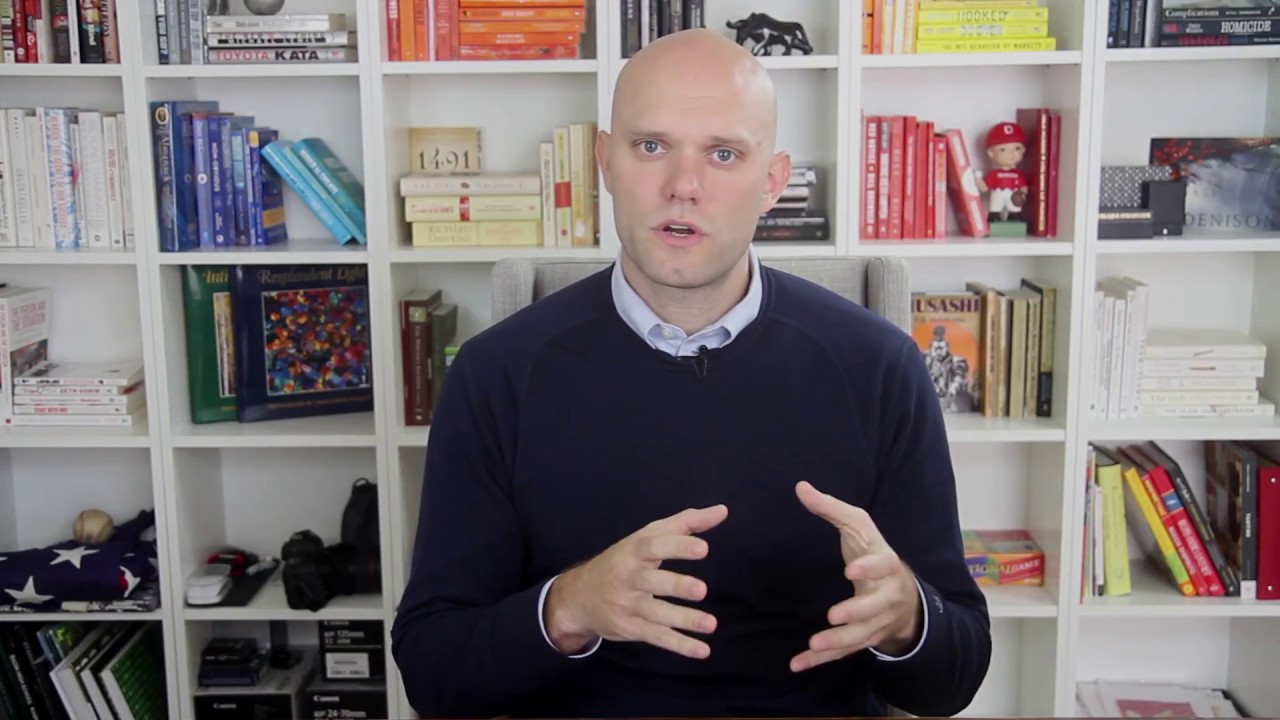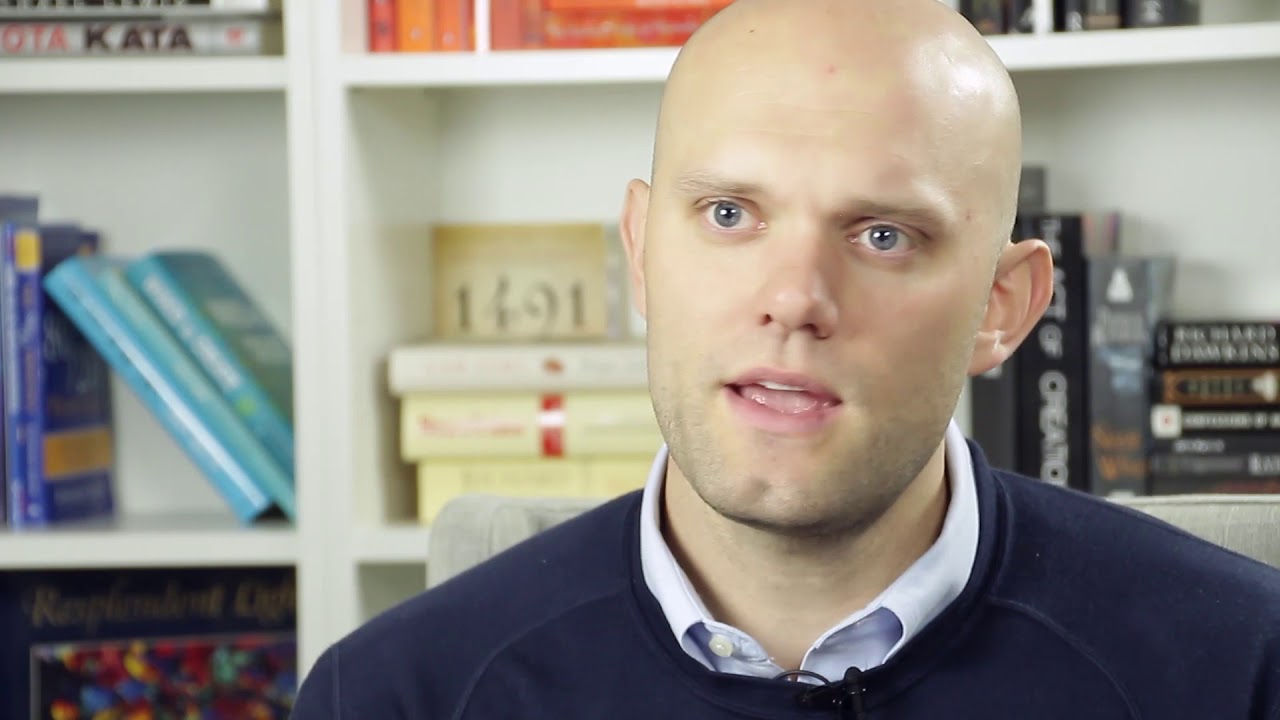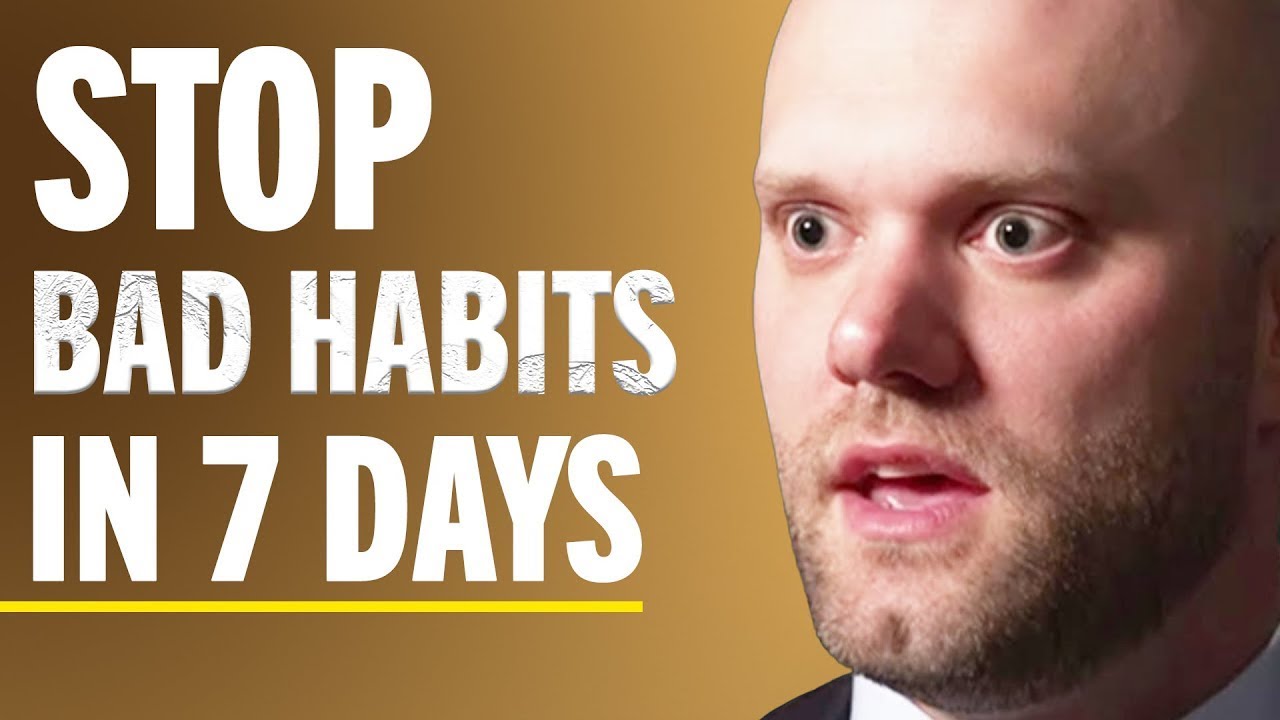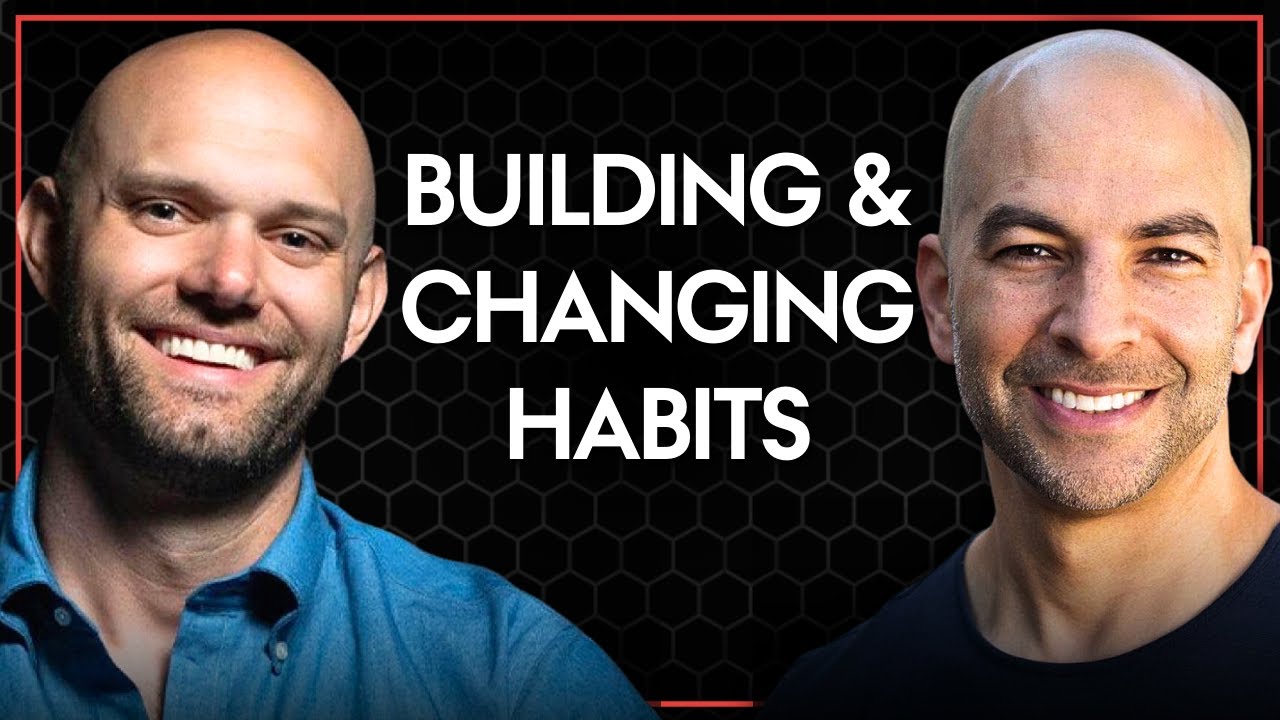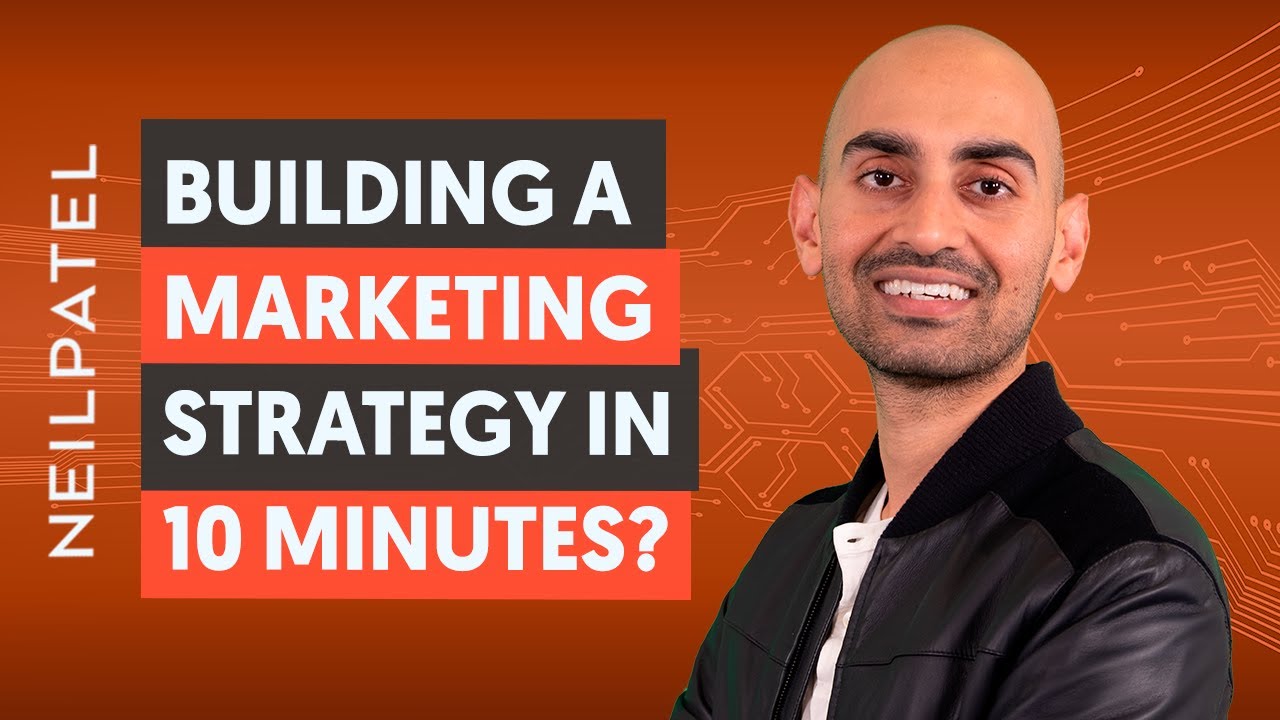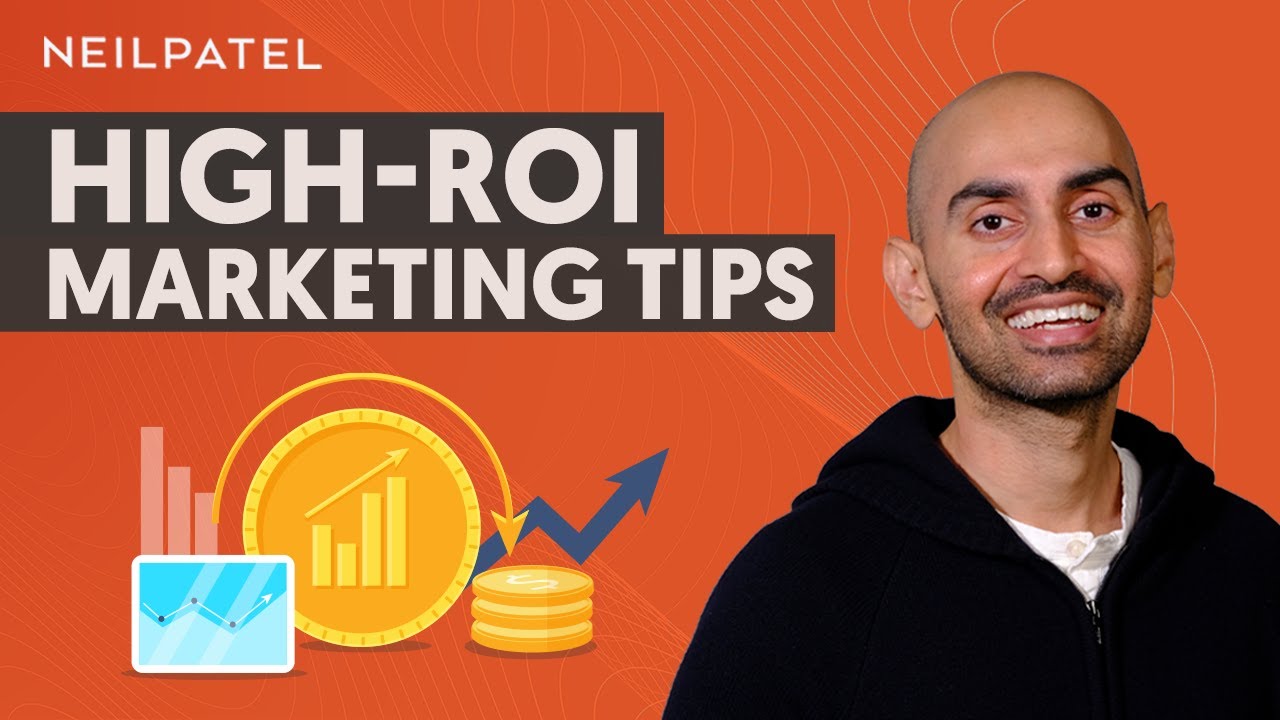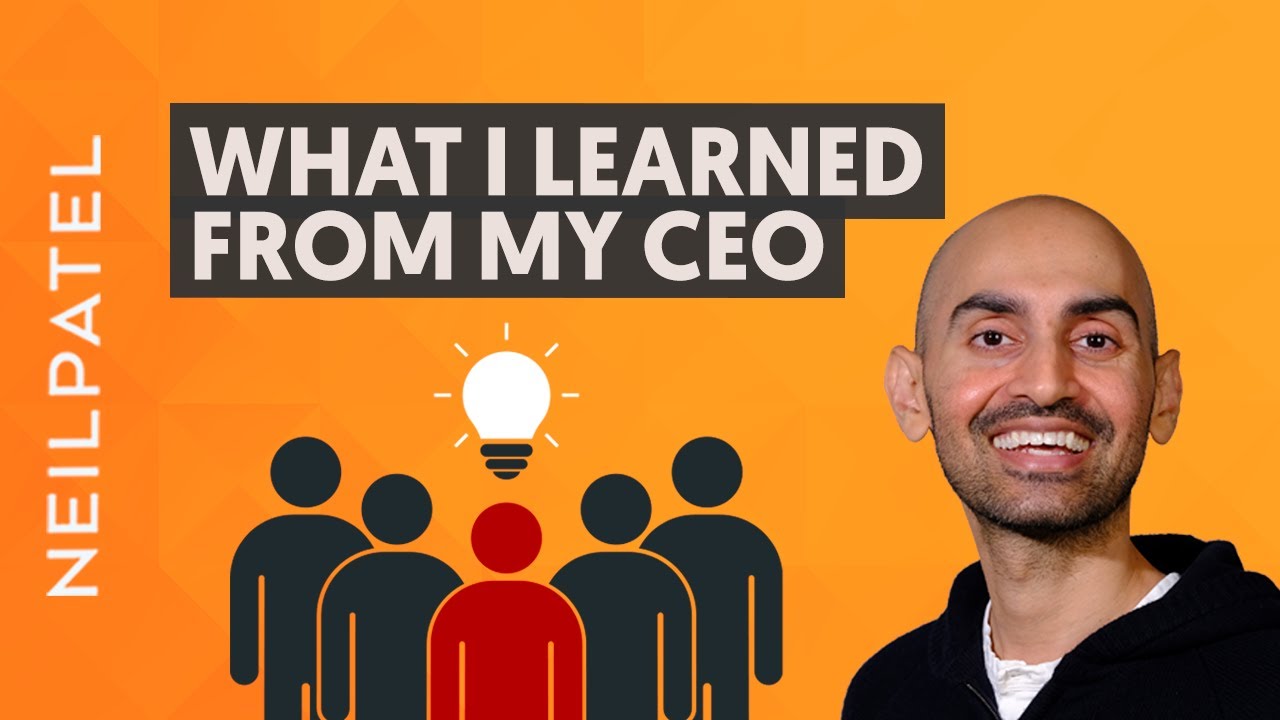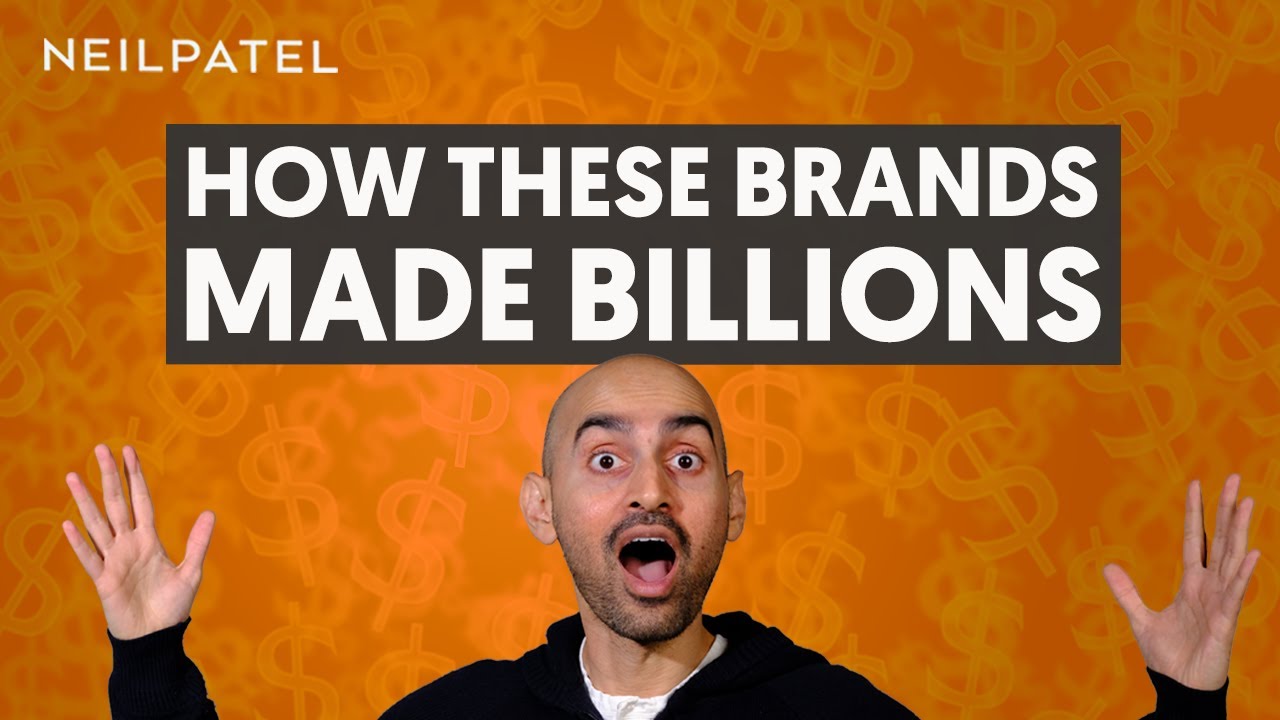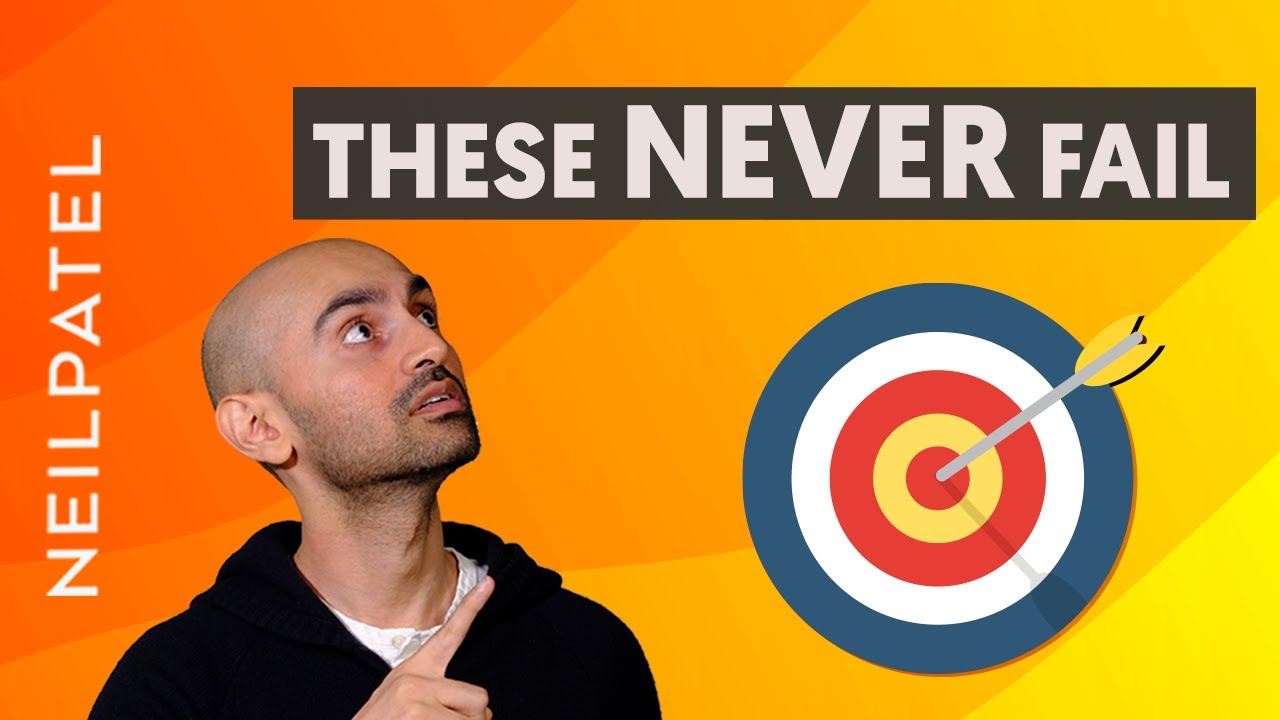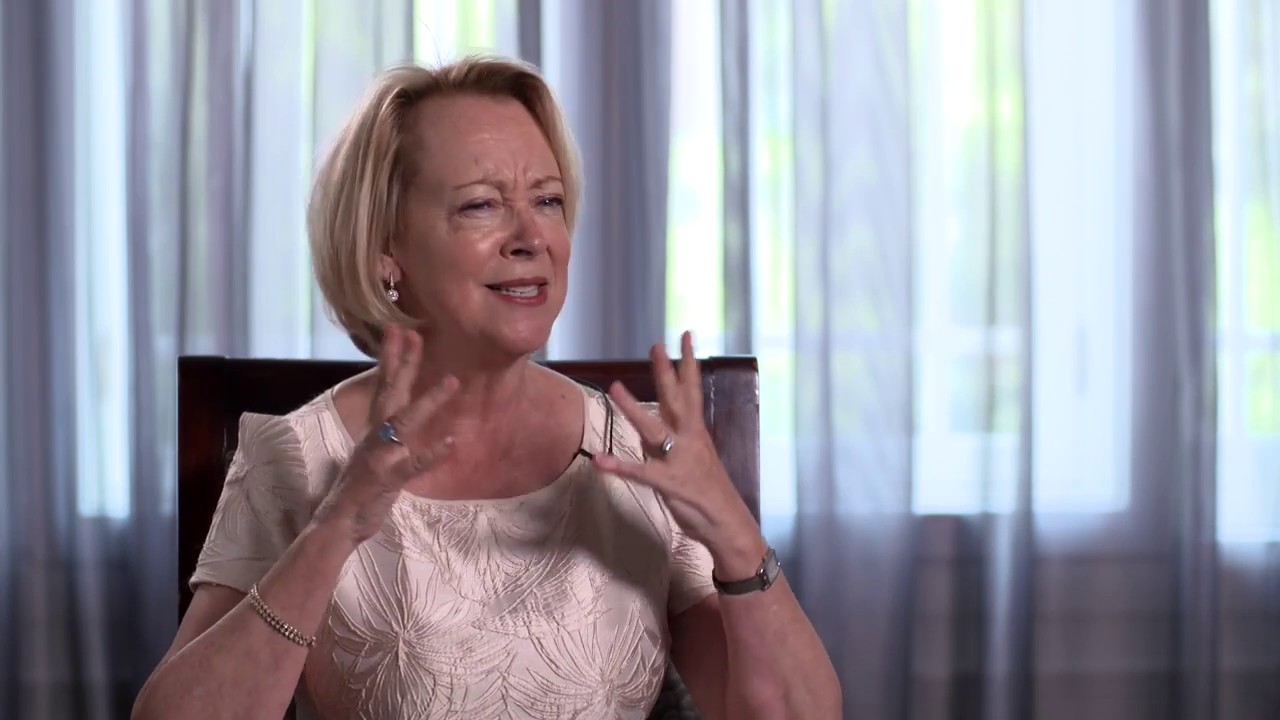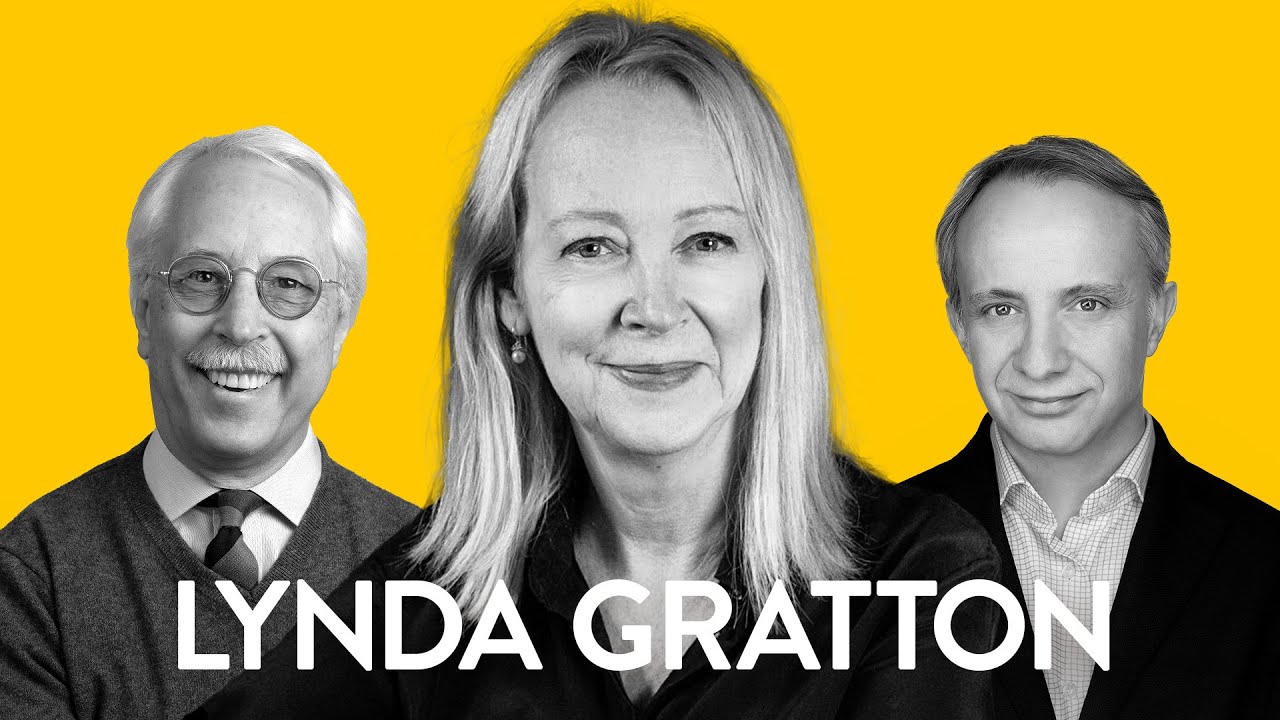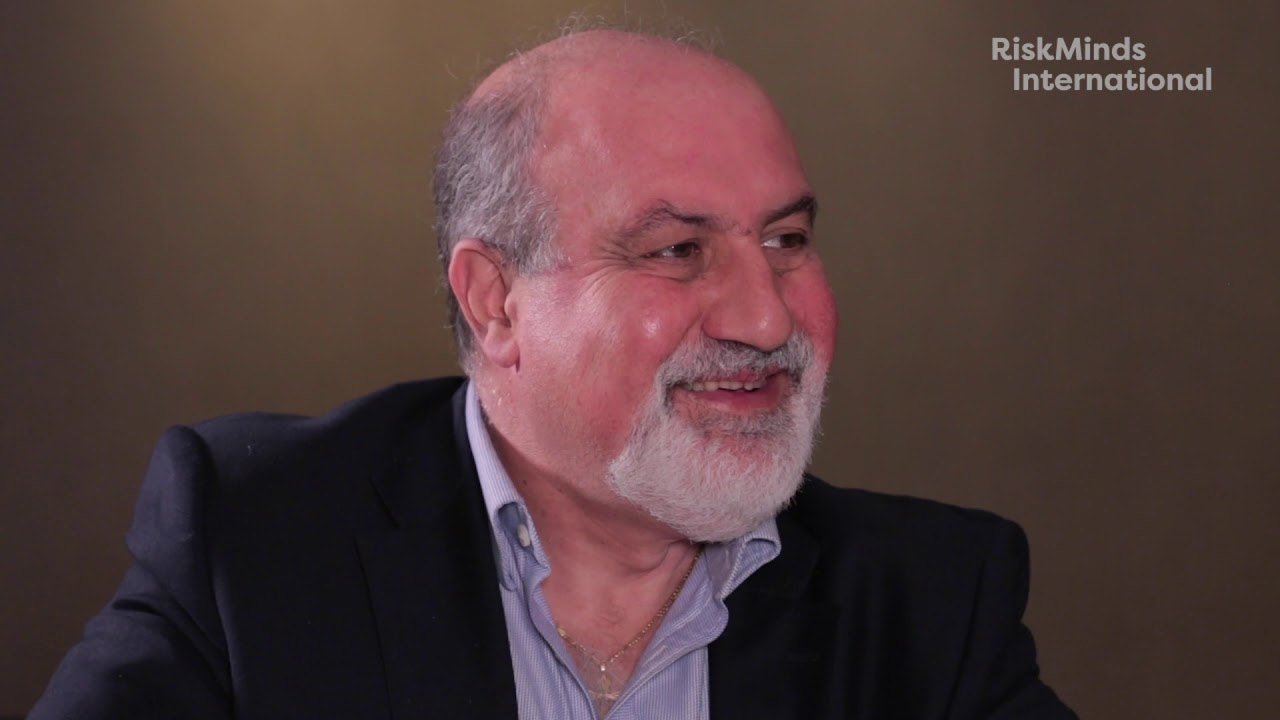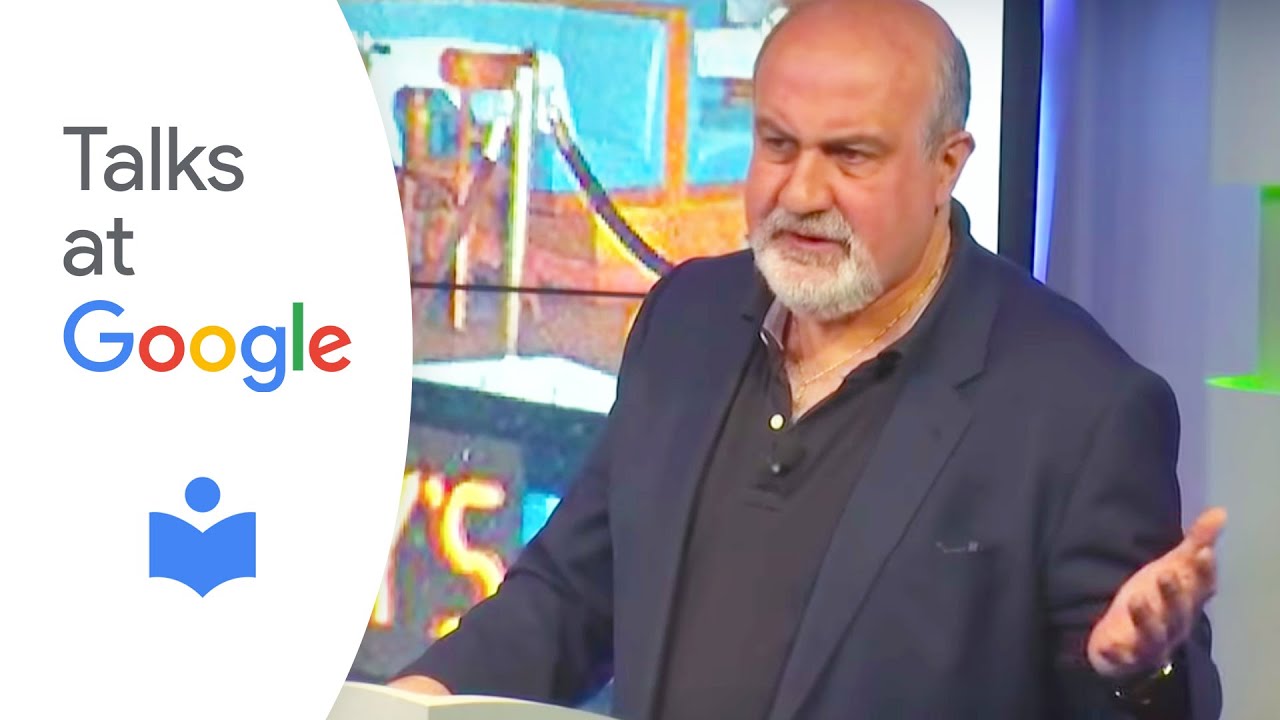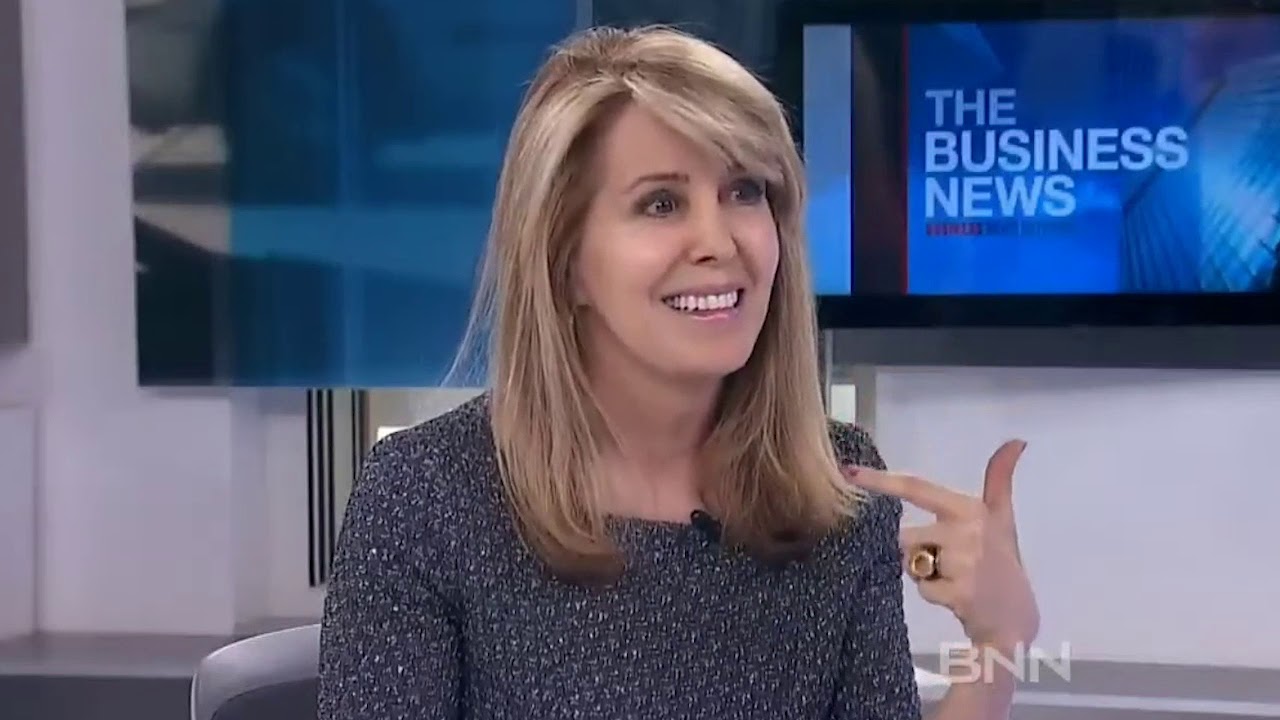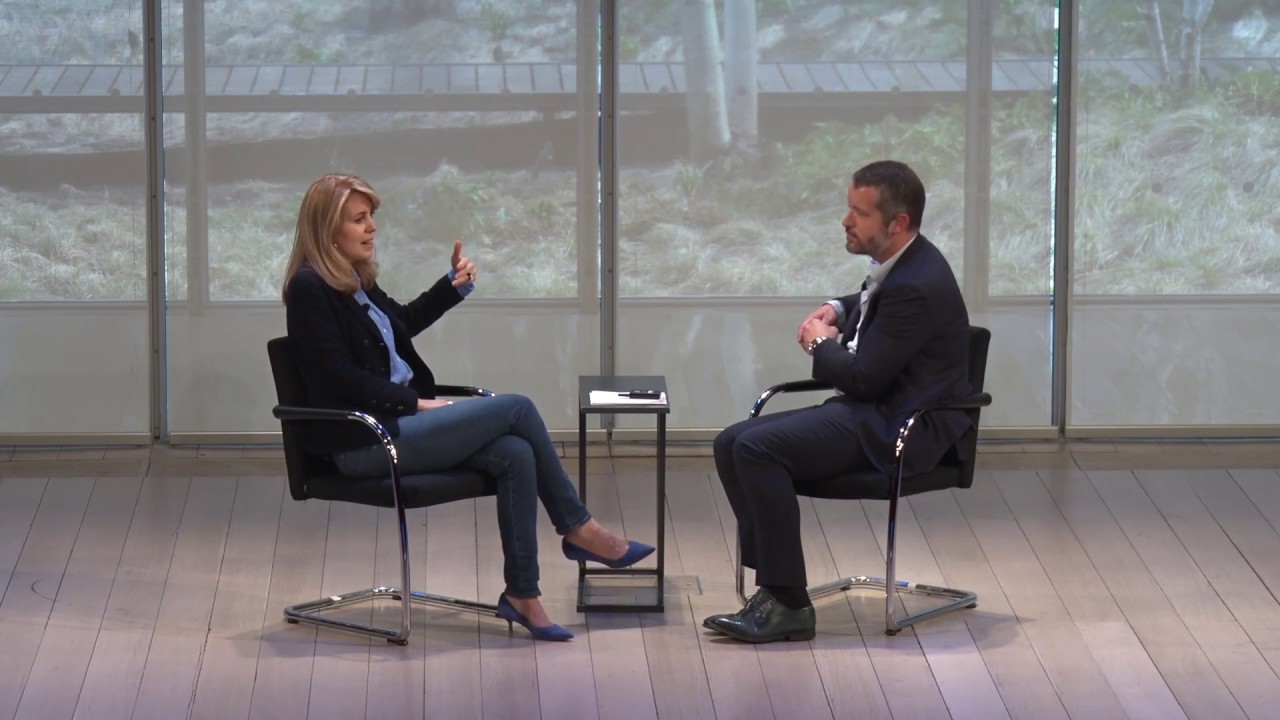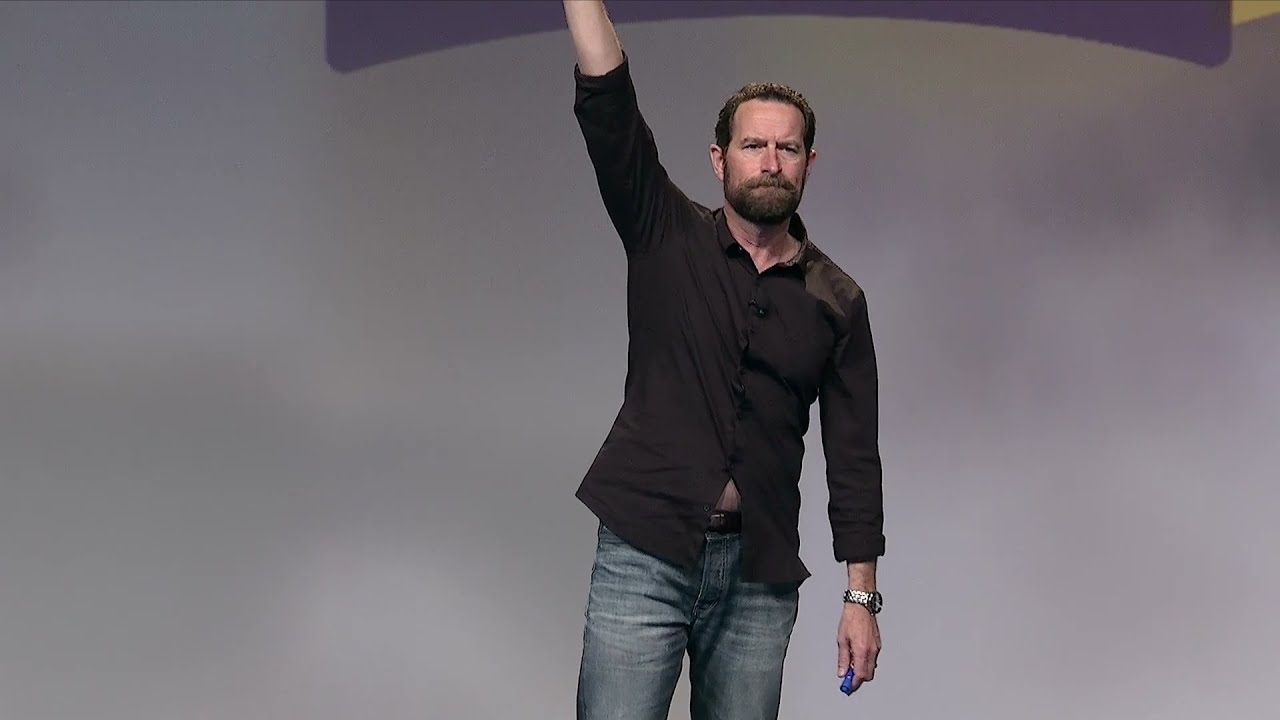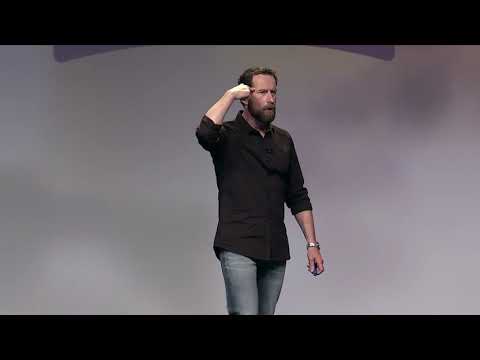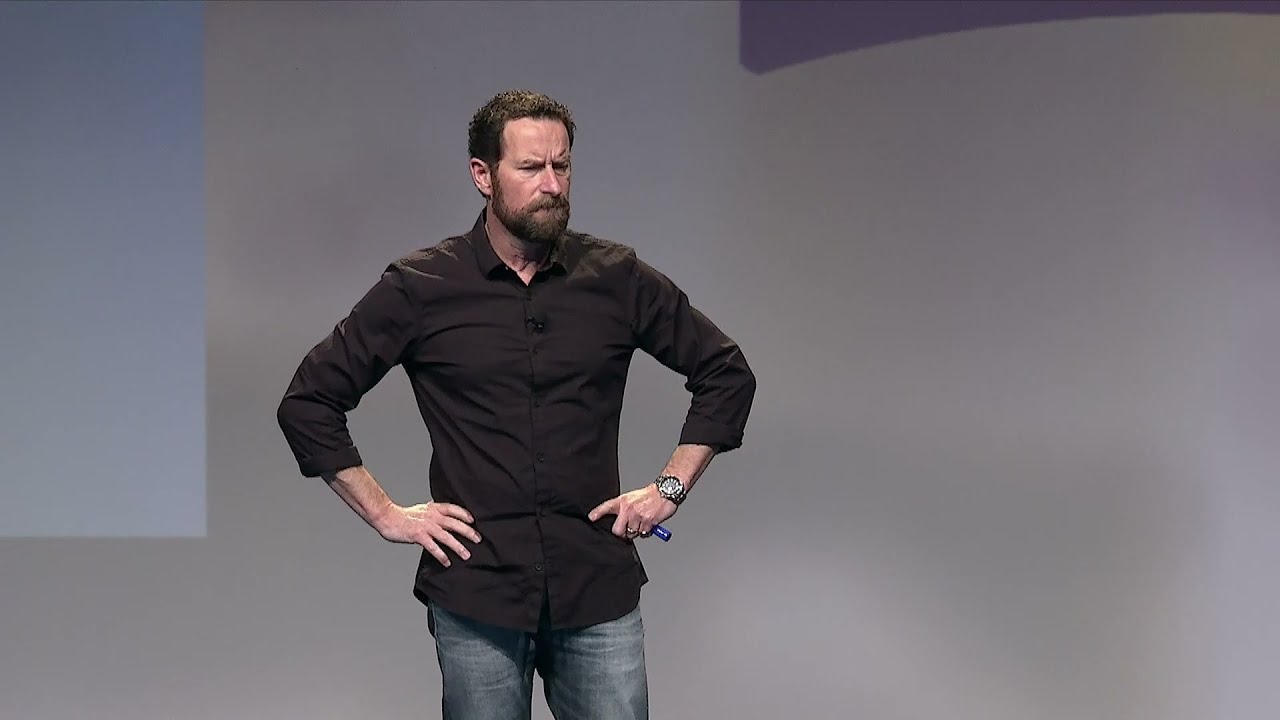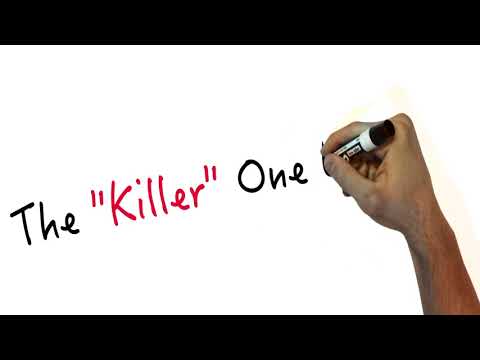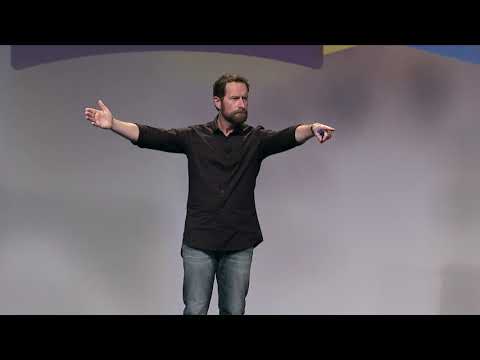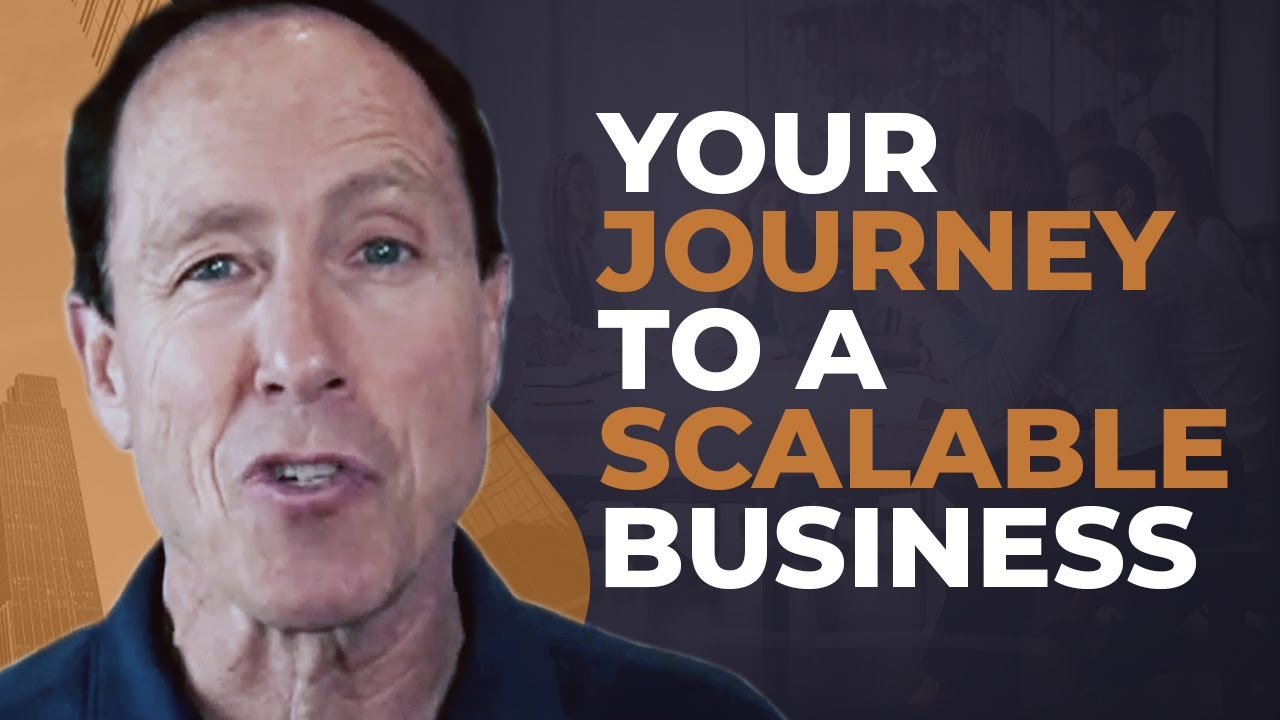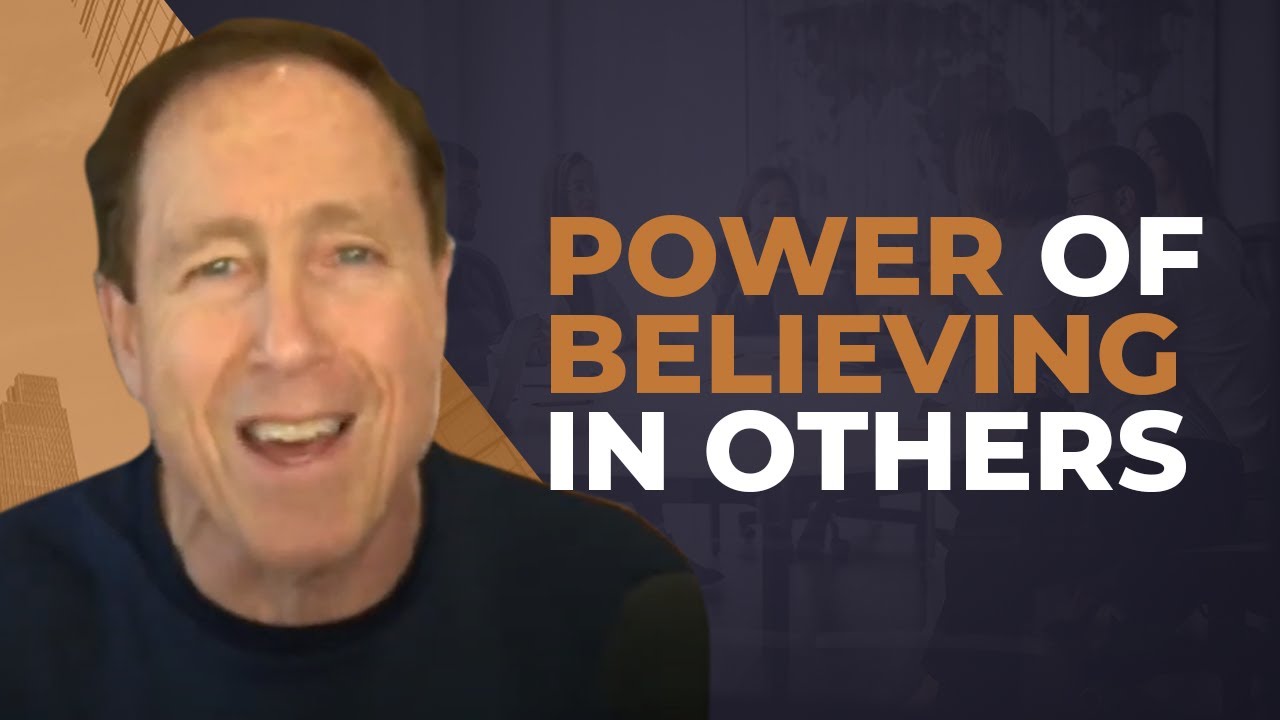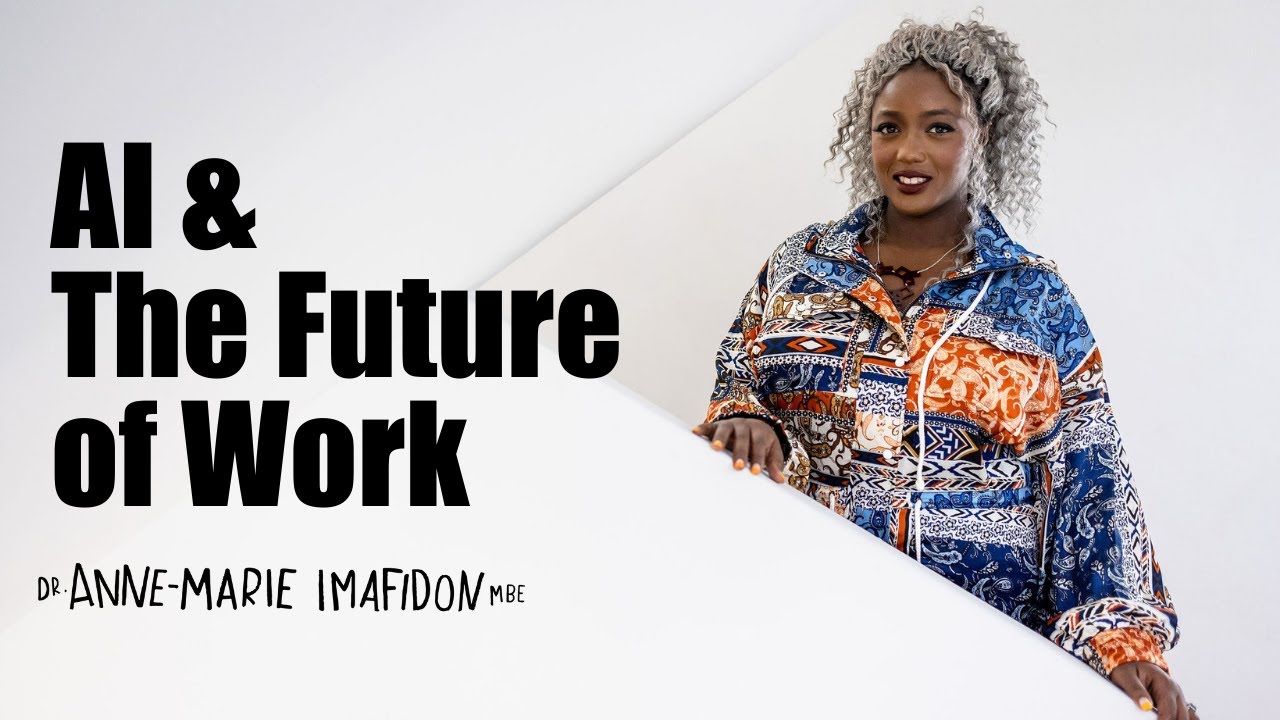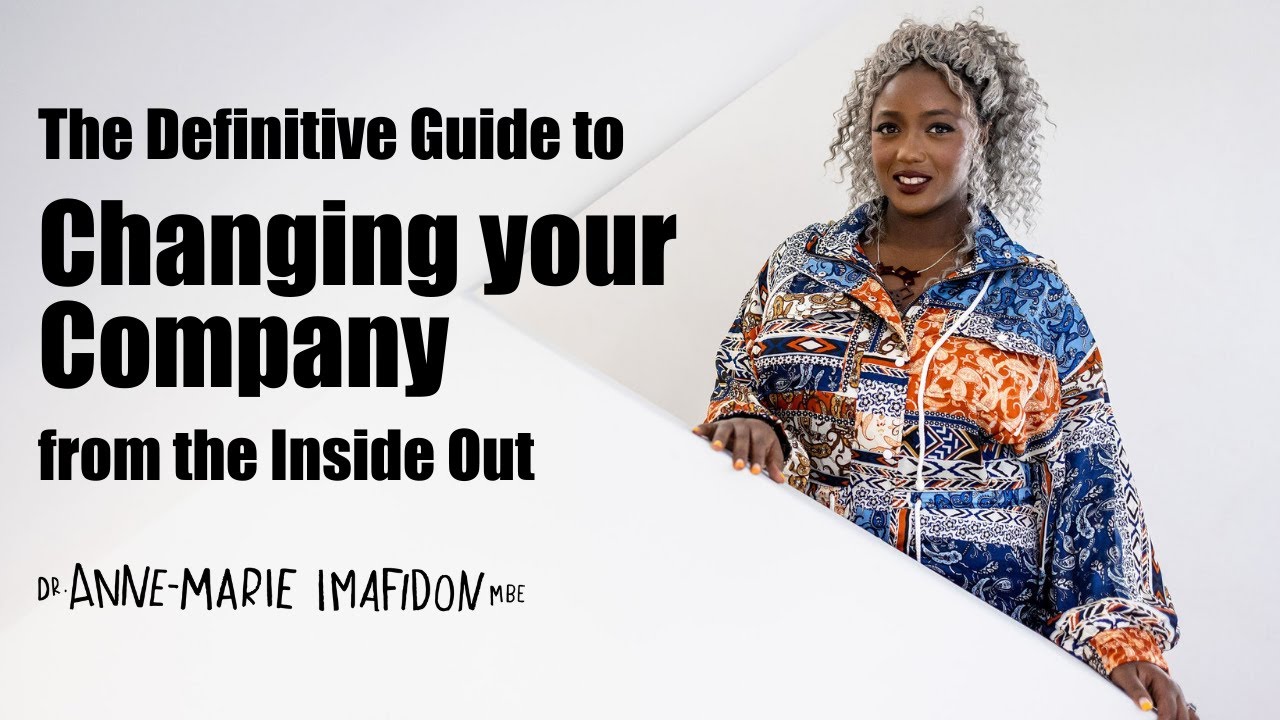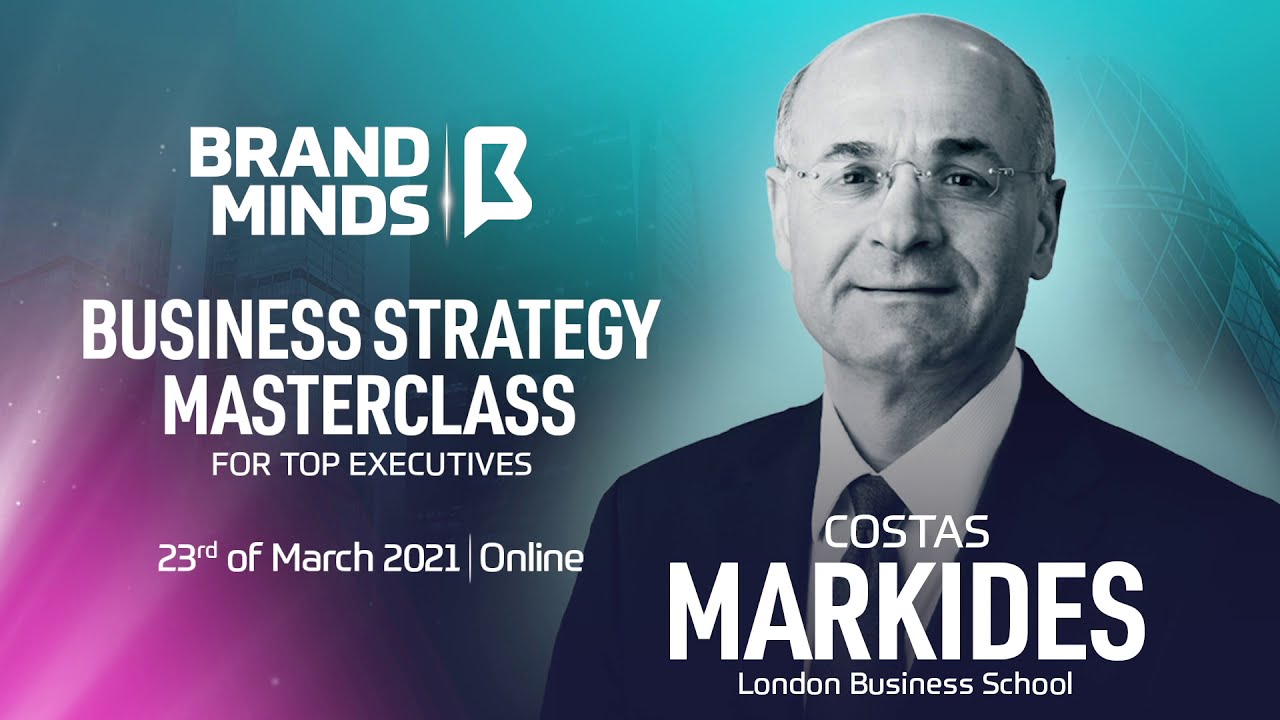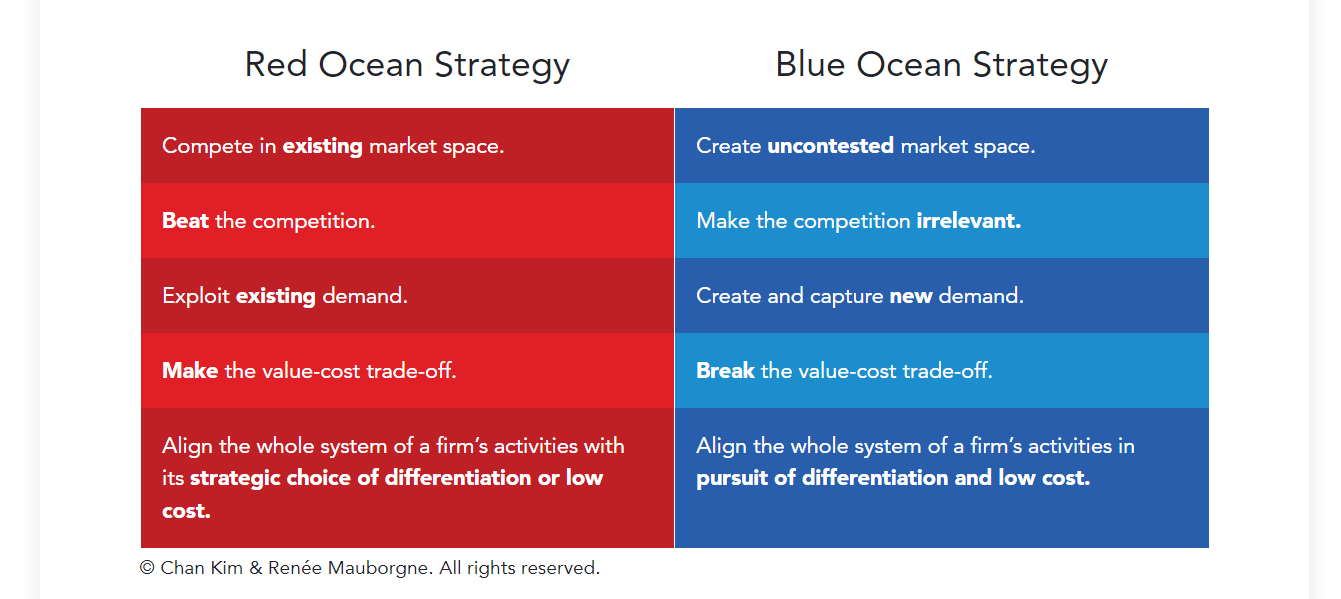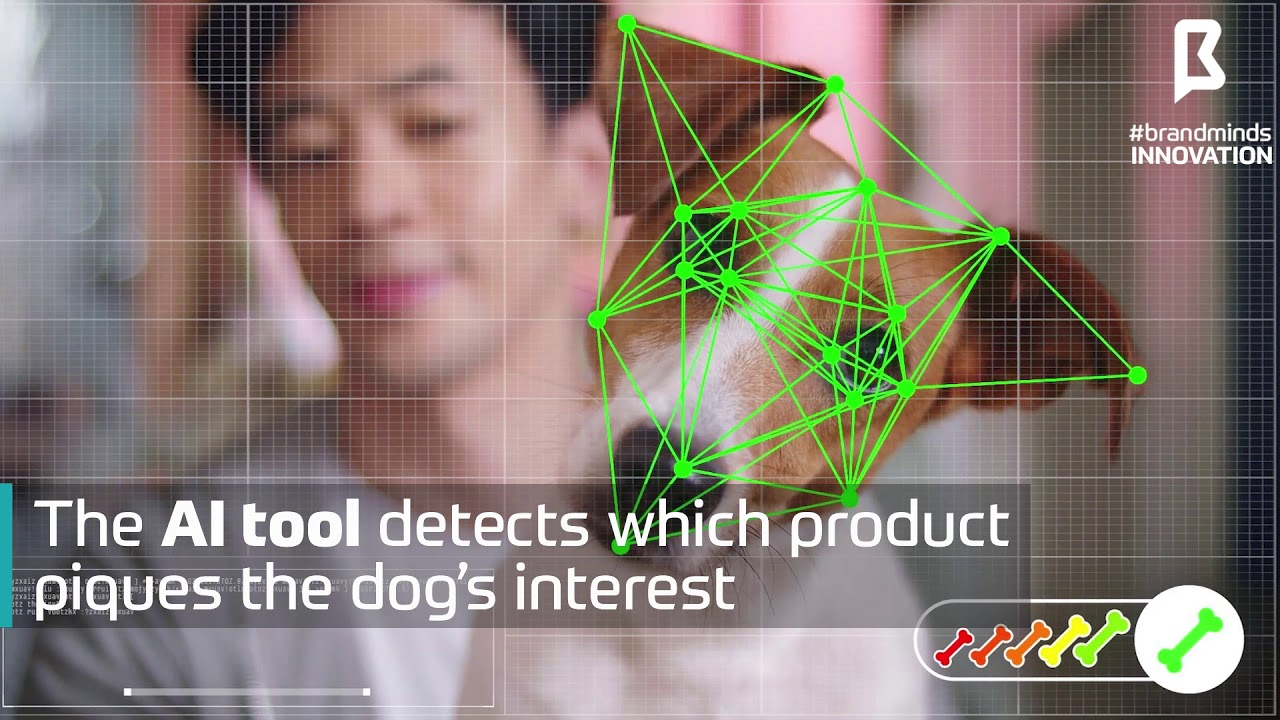UniCredit Bank’s Commitment in Romania: Empowering Youth through Education and Innovation
For more than two decades, UniCredit Bank S.A. has been a steadfast supporter of education, entrepreneurship, and social impact in Romania, with a strong focus on empowering youth and fostering sustainable business practices. Through strategic programs and partnerships, the bank aims to build a generation of well-prepared, financially literate, and socially responsible individuals who can shape the future of the country.
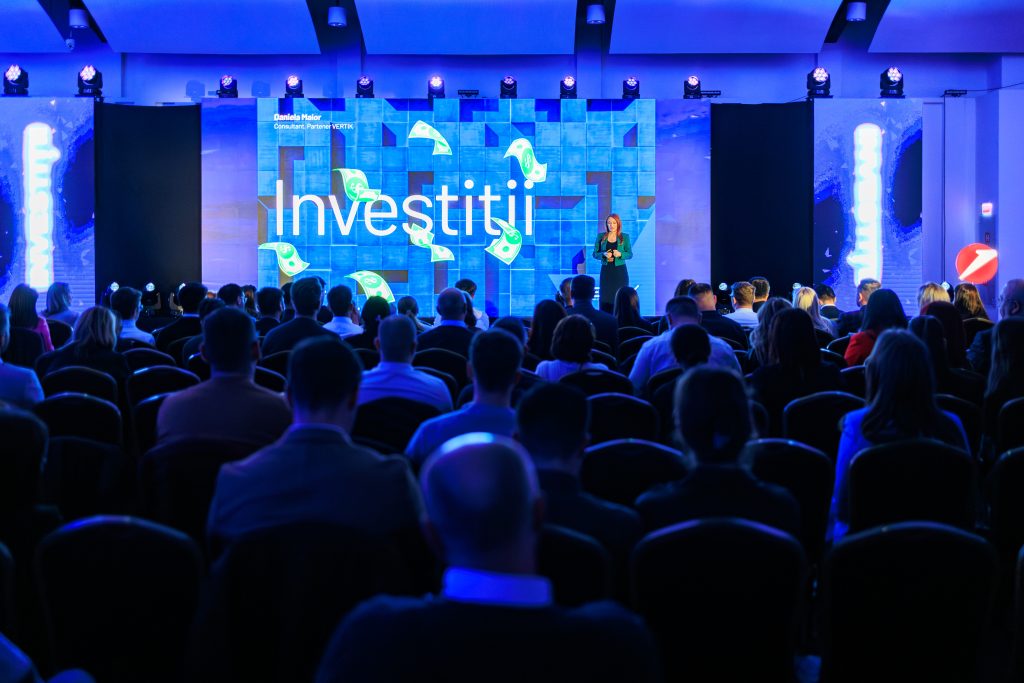
At the heart of UniCredit’s social mission is a desire to identify, finance, and promote individuals and businesses that generate both economic and societal value. The bank believes that sustainable business is essential not only for its own long-term health, but also for the prosperity of its clients and the communities it serves.
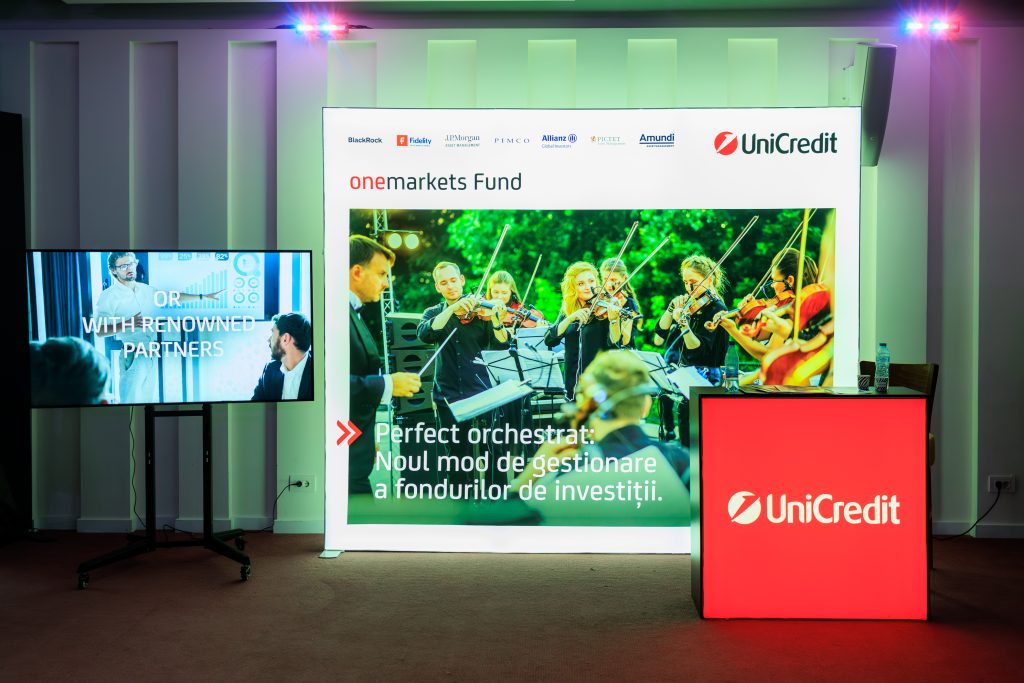
Fostering Entrepreneurship and Innovation
UniCredit Bank has been instrumental in launching and supporting initiatives that empower young entrepreneurs and drive innovation. Some notable programs include:
- F&B Business Accelerator & Innovation Camps – tailored support for HoReCa entrepreneurs;
- Techsylvania International Conference – promoting tech innovation and leadership;
- The Entrepreneurs Tours – a series of educational events across major Romanian cities;
- Endeavor Romania’s scale-up and mentoring programs – designed to accelerate high-impact ventures.
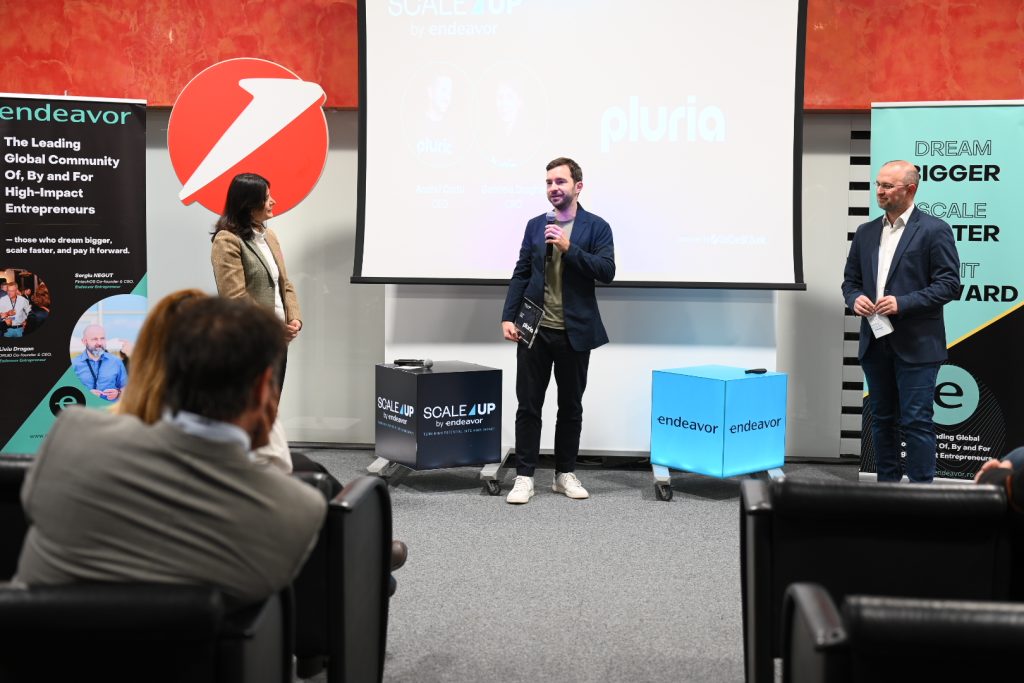
Financial Education for the Next Generation
Over 5,500 young people have already benefited from UniCredit Bank’s two flagship financial education programs:
- Start Major (6th edition), implemented by the Social Incubator Association, equips youth with skills in financial literacy, career development, and entrepreneurship, preparing them for independence and the job market.
- Smart Leo (2nd edition), in partnership with Lions Club Decan, focuses on basic financial education while also promoting sustainability awareness and encouraging youth-led sustainable business projects.
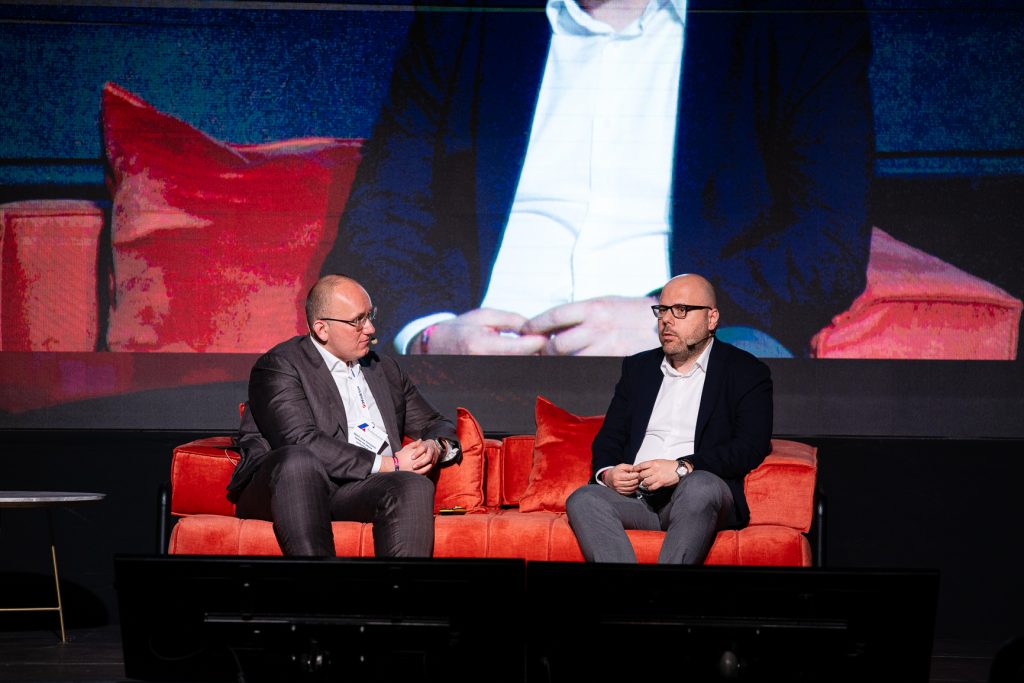
Advancing Academic and ESG Education
In a pioneering initiative, UniCredit supported the West University of Timișoara in launching Romania’s first postgraduate course on ESG reporting and sustainable finance. The program, inaugurated on ESG Day – November 14, 2024, addresses the national gap in ESG expertise. To date, 63 graduates have earned diplomas, contributing to the country’s transition to a more sustainable economy.
The bank also proudly funds Skills for Transition, a comprehensive training program that prepares students, NEETs, and companies facing challenges from the green transition to develop the competencies needed for a changing labor market.
Nurturing the Next Tech Giants
One of the latest additions to UniCredit’s youth empowerment efforts is TEKUNI, a specialized mentoring and growth program for university students aspiring to launch their own tech startups.
TEKUNI includes 8 modules where participants gain practical knowledge in business models, marketing, sales, team management, entrepreneurial mindset, organizational culture, product development and more. The program concludes with Demo Day, an event where participant teams prepare their startup ideas and pitch them to a jury of investors. The jury selects 3 startups with high potential for investment and provides the teams with feedback and recommendations.
The program bridges the gap between academic learning and real-world entrepreneurship, equipping students with essential tools, expert mentorship and access to a strategic network of investors and venture capital firms. Through TEKUNI, aspiring founders gain the resources and connections needed to transform innovative ideas into successful, scalable businesses.
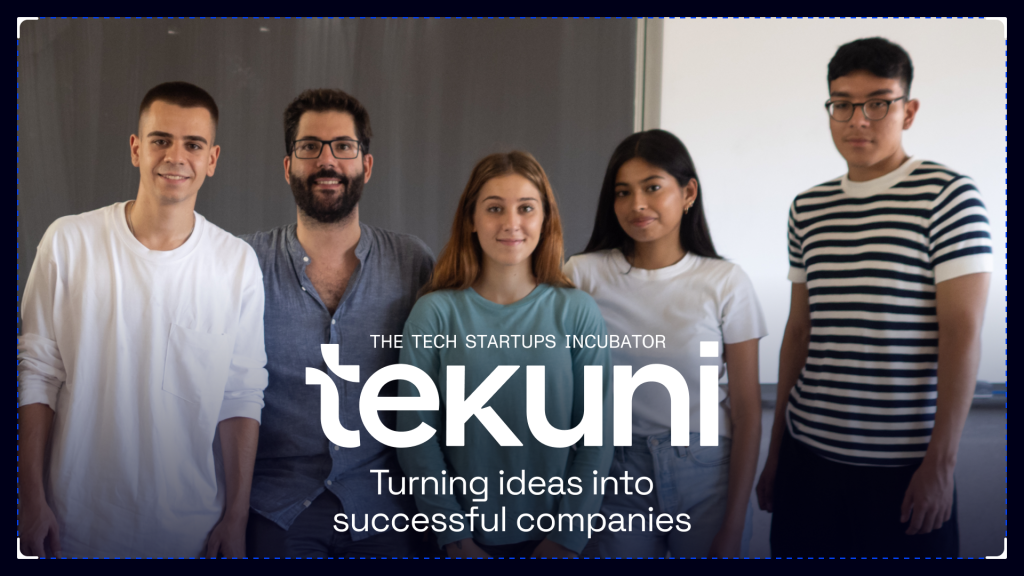
Supporting the ESG Transition for Companies
To help businesses adapt to and capitalize on ESG trends, UniCredit launched three programs:
- ESG Journey – a national series of events on sustainability and ESG reporting;
- ESG Journey+ – in-depth workshops on transforming ESG compliance into competitive advantage.
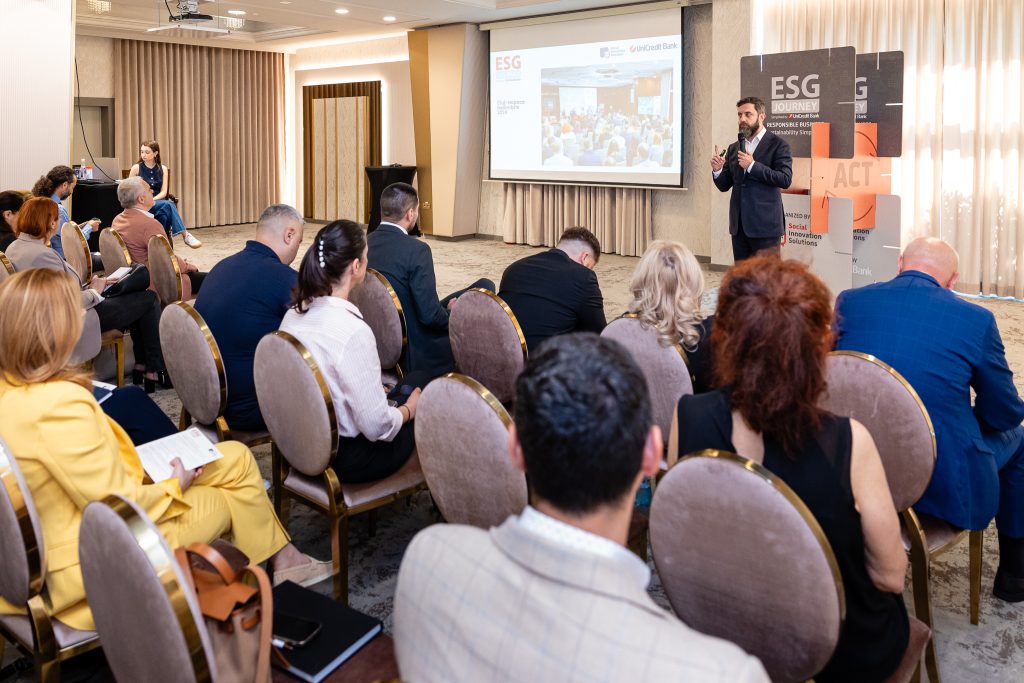
With these two programs, we will reach 7 cities by the end of this year and we will meet with over 500 companies and discuss the risks and opportunities that the sustainable transition brings.
- ESG Lab – a local program dedicated to companies that expect to be impacted by the green transition. In 2024, the first edition took place, in which 23 companies took the first steps to create not only a transition plan, but also value, focusing on the opportunities resulting from integrating sustainability into their strategies. In 2025, we will increase the complexity and applicability of the program and aim to work with 25 corporate clients.
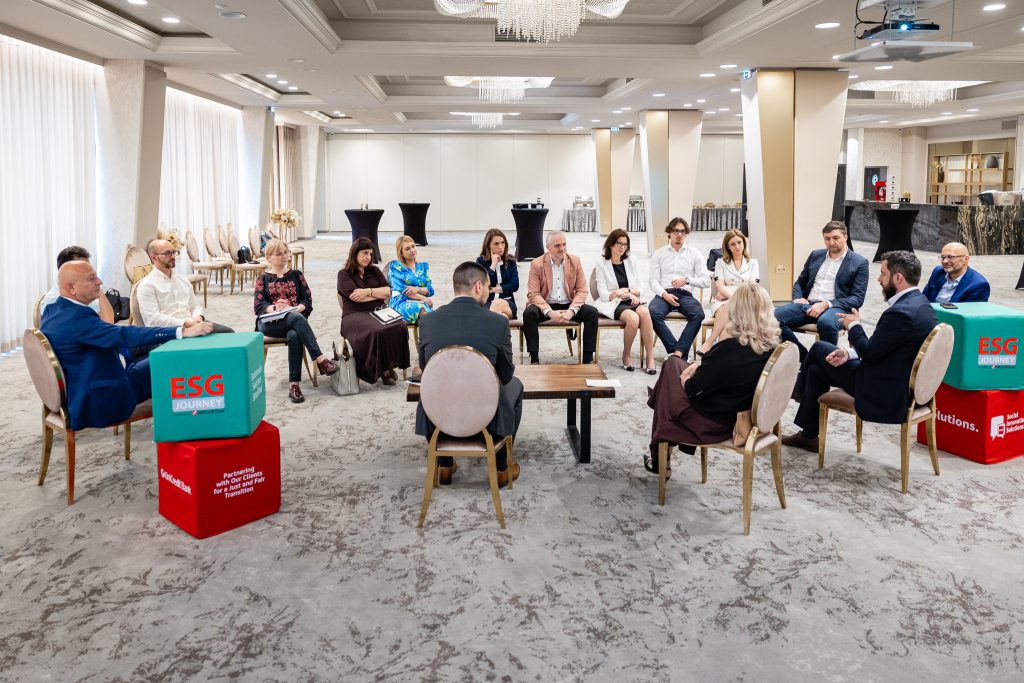
A Sustainable Vision for Romania’s Future
Through these diverse initiatives, UniCredit Bank S.A. is not only financing business and economic growth, but also shaping the next generation of socially-conscious leaders and innovators. By bridging the gap between education, entrepreneurship, and sustainability, the bank reaffirms its commitment to building a more inclusive, competitive, and future-ready Romania.
26 key video lessons on business and personal growth you should see today
Take the reins of your personal and professional growth with 26 video lessons from global business thinkers speaking at BRAND MINDS 2023.
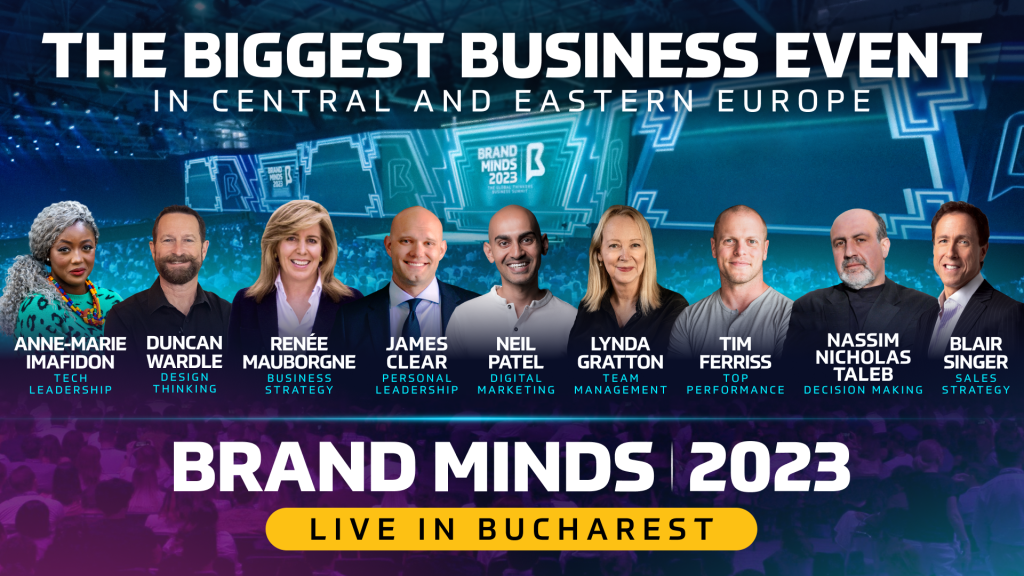
Video lessons on PERSONAL GROWTH with JAMES CLEAR, Bestselling Author of ‘Atomic Habits’
1. How to trigger good habits automatically
2. How long does it take to form a new habit
3. How to get 40 times better at anything
4. Building and changing habits
Video lessons on DIGITAL MARKETING STRATEGY with NEIL PATEL, Digital Marketing Expert
5. How to build a marketing strategy in 10 minutes
6. Seven underrated marketing tips
7. Key lessons learned from hiring a CEO
8. Unique marketing lessons from billion-dollar companies you’ve never heard of
9. Four digital marketing strategies that just work
Video lessons on HOW IS FUTURE OF WORK IMPACTING YOUR COMPANY with LYNDA GRATTON, Future of Work Strategy Expert @London Business School
10. The 2 key factors redesigning today’s workplace
11. Redesigning work
Video lessons on the GLOBAL ECONOMY with NASSIM NICHOLAS TALEB, Author & Risk Analyst
12. What are the greatest risks facing the global economy
13. Why ‘Skin in the Game’ is necessary to make sense of the world at large
Video lessons on BUSINESS GROWTH STRATEGY with Renée Mauborgne, Bestselling Author of Blue Ocean Strategy & Blue Ocean Shift
14. How to find new business growth opportunities in 3 essential steps
15. How to create exceptional business growth through the Blue Ocean Strategy
Video lessons on INNOVATION & CREATIVITY with DUNCAN WARDLE, Innovation Expert & Creative Director of Disney
16. What is a simple way to get new ideas
17. How to challenge people to develop remarkable ideas
18. What is the Moon Shot Thinking and what rules you should be challenging to get to it
19. How to get into the right state of mind to innovate at work
20. How to solve your business challenge by looking around the world of innovation
Video lessons on SALES STRATEGY SECRETS with Blair Singer, World Famous Sales Expert
21. Three secrets to winning every sales pitch
22. Six things that will give you an instant advantage in front of everyone
23. How to start your journey to a scalable business
24. How to build the dream team in the business
Video lessons on ARTIFICIAL INTELLIGENCE AND THE FUTURE OF WORK with ANNE-MARIE IMAFIDON, Tech Leadership Expert
25. Why leaders should adopt A.I. to future-proof their businesses
26. The definitive guide to changing your company from the inside out
BRAND MINDS: 30 top reasons to bring your team
BRAND MINDS is among the Top 5 largest business conferences in Europe providing its attendees with a unique business edutainment experience.

More than 6000 professionals from 500 companies in 80 countries attended BRAND MINDS on June 2nd and 3rd, 2023.
Bring your team to BRAND MINDS because teams who learn together will grow the company together.
30 reasons to bring your team to BRAND MINDS
You and your team will:
#1 Learn business strategy from the most respected business experts in the world;
#2 Access the opportunity to interact with +7000 business specialists from over 50 countries;
#3 Reconnect with business partners from +11 industries;
#4 Learn how to create an organizational culture where people develop exponentially;
#5 Discover the latest trends in design thinking & innovation;
#6 Discover new models of leadership & team management;
#7 Discover the latest trends in professional development;
#8 Enjoy the most memorable teambuilding yet;
#9 Connect with the latest trends in technology & artificial intelligence;
#10 Learn tactics to overcome any sales objection;
#11 Learn to build an effective digital marketing strategy for your company.
#12 Learn new techniques to develop healthy habits that will help you achieve your vision;
#13 Learn techniques to amplify autonomy & innovation in your team;
#14 Enjoy a complex learning experience, equal to reading 8 books in a day;
#15 Leave with at least 3 actionable ideas to scale up your company;
#16 Discover 8 habits that amplify creativity in a team;
#17 Learn the most effective risk management strategies;
#18 Learn to develop a high-performing sales team;
#19 Learn the latest tactics in sales strategy to close big clients;
#20 Access the opportunity to build new business partnerships;
#21 Network with decision-makers from +300 Top companies;
#22 Discover global economic trends that will help you adapt your business strategy for the future;
#23 Learn team engagement techniques through design thinking;
#24 Learn how to achieve the most ambitious career goals without facing burnout;
#25 Discover artificial intelligence tools that will help your company adapt for the future;
#26 Learn the most common mistakes leaders make that result in team demotivation;
#27 Learn the latest strategies and frameworks of customer loyalization through digital marketing;
#28 Leave with the BRAND MINDS World-Changer participation certificate;
#29 Meet authors among the most respected internationally in a live, in-person event;
#30 Access the opportunity to interact with some of the most renowned business experts of the moment.
3 drivers of innovation: customers, product, service
In our previous article on innovation, What are the 4 types of innovation? we talked about how employers are expecting employees to have innovation-focused skills, the definition of innovation, the difference between innovation, creativity and invention and the 4 types of innovation.
Innovation is a broad subject and therefore can be a daunting challenge for anyone trying to approach it. My solution is to place the information in categories. Organizing information in whatever way feels comfortable for you (lists, diagrams etc) improves your learning process greatly.
For the present article, let’s go deeper into the conversation on innovation and answer the following questions:
What drives innovation?
What stands at the core of innovation-centred efforts?
What is the first step toward innovation?
In this article:
- Customer-led innovation: customer-driven innovation, customer-centred innovation, customer-focused innovation;
- Product innovation: definition and example;
- Service innovation: definition and example.
The drivers of innovations are customers, products and services.
The first step on your path toward innovation should be deciding where to focus your efforts.
Are you going to focus on your customers and create products that meet their needs? Will you focus on product development?
Or find a new way to serve your customers?
Let’s discover more about each innovation driver!
Customer-led innovation
Customer-led innovation is when the company finds an innovative solution to a demand arising from the customer experience & dissatisfaction with the choices currently available in the marketplace.
Examples of customer-led innovations:
- The extended battery life for smartphones;
- LEGO plastic bricks with tubes inside stick together thus preventing the constructions from falling apart;
- Bumble, the dating platform allowing only female users to make the first contact with matched male users;
- Canva, the design platform for non-designers who had neither the money nor the time to invest in professional tools like Photoshop;
- Amazon’s Show and Tell feature allows the blind to identify grocery items by holding each item to the Echo Show camera and asking, “Alexa, what am I holding?”.
According to this paper published in the award-winning Research Technology Management journal, customer innovation “has become an essential strategy for organizational survival.”
There are 3 types of customer innovation:
- Customer-driven innovation
- Customer-centred innovation
- Customer-focused innovation
What is customer-driven innovation?
At the centre of customer-driven innovation is the customer.
The innovation is made by the customer with the organization having a coordination role. The end result is an innovation that is dynamic, impossible to control and difficult to get to the market. The entire process is time-consuming and requires high levels of interaction between the customers and the organization.
What is customer-centred innovation?
Customer-centred innovation is about innovating with customers.
At the centre of this type of innovation are the customer AND the organization. The role of the organization is that of the communicator. This type of innovation is open, difficult to control and coordinate. The main challenge: there’s no shortage of ideas; the difficulty stands in the organization’s ability to develop them.
What is customer-focused innovation?
Although it’s called customer-focused innovation, at the centre of this type of innovation is not the customer, but the organization alone. A customer-focused innovation is where the organization innovates for the customer.
The organization discovers customer needs and seeks to satisfy them by expanding the choices available within a product category.
The organization is the innovator. The innovation is closed, easy to control and coordinate. The main challenge of this type of innovation is that it requires an ongoing process of customer analysis.
Here are all three types of customer innovation in one picture:
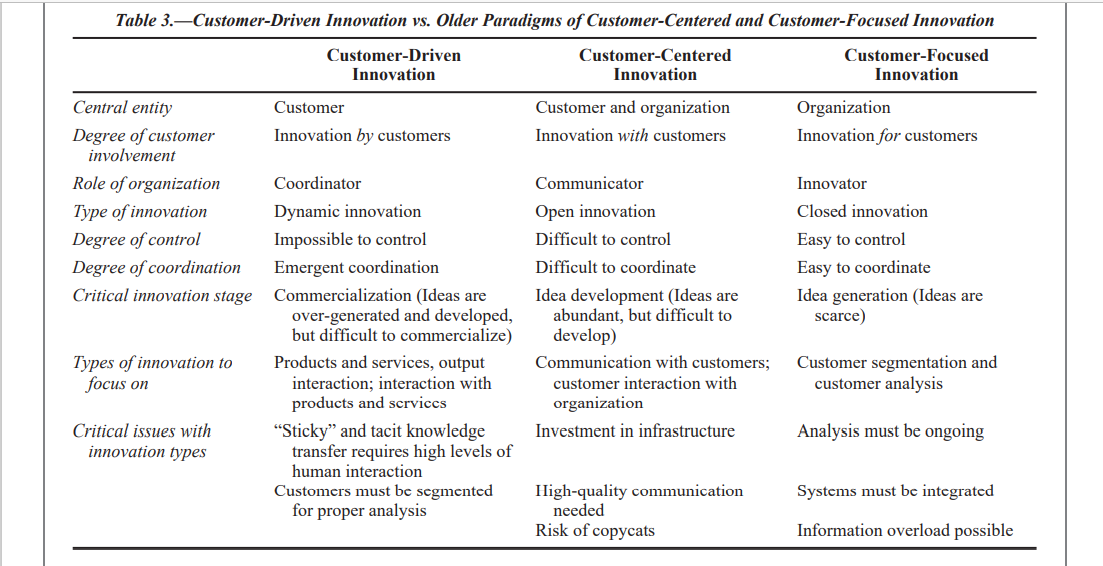
ServiceNow – customer-led innovation example
ServiceNow is a platform that lets people automate workflow in a business. The company was ranked #1 by Forbes in its 2018 World’s most innovative companies list.
ServiceNow delivers digital workflows that create great experiences and unlock productivity. This is the future of work. Behind every great experience is a great workflow.
The company was founded by Fred Luddy in 2004. In an interview with Forbes, Fred Luddy says he’s never had an original idea but has always paid close attention to anybody doing, struggling to do or wishing they could do it differently.
In his opinion, the company must “deeply, deeply, deeply understand customer needs”.
Also, technology must be used in the service of the employee. In keeping with his words, he met with over 500 customers and asked every one of them these questions:
What are your most important priorities? What keeps you up at night?
And regarding ServiceNow, what are we doing well? And—very importantly—where can we get better?
Product innovation
Product innovation is the development and market introduction of new, redesigned, or substantially improved goods.
Apple – Product innovation example
When you say product innovation and development, you say Apple.
The $2 trillion tech company has been launching new products in every one of its product lines every year since the company’s foundation four decades ago.
Apple’s goal is to create the world’s best products which are also what consumers want. The company has set out to make only great products by constantly focusing on innovating.
Innovation is making things better and not just merely changing. And that requires a depth of fall which is well beyond merely changing something.
Tim Cook
Service innovation
Service innovation is changing the way you serve your customers to create greater value for them and deliver more revenue for your organization.
It’s about providing customers with an amazing and improved experience that wasn’t available before.
L’Oreal – Service innovation example
L’Oreal is one of the most innovative companies in the global beauty market.
As per the company’s 2020 Research, innovation & beauty tech report, L’Oreal has invested 964 million euros in Research & Innovation.
The beauty company has embraced the digital revolution as early as 2012. Since then L’Oreal has integrated technology to serve customers better and more efficiently.
One example is the brand’s use of Augmented Reality and Artificial Intelligence to virtually try on its products.

At CES 2020, L’Oreal unveiled Perso, an AI-powered at-home system.
The device delivers on-the-spot skincare and cosmetic formulas that optimize for increasing levels of personalization over time.
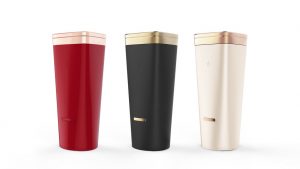
Here’s what Nicolas Hieronimus, L’Oréal’s Deputy Chief Executive Officer had to say about the company’s innovation goals:
Building on our deep scientific heritage and leadership in innovation, L’Oréal is once again leveraging advanced technology to create smart beauty products and services that answer the needs of our consumers and offer them near-limitless personalization and precision.
What are the 4 types of innovation?
Innovation – the #1 soft skill companies are looking for
Last year, the World Economic Forum in collaboration with LinkedIn released its 2025 Future of Jobs report.
This report maps the jobs and skills in the next five years.
As you can see below, innovation ranks at #1 in the Top 10 skills employers are looking for in an employee in 2025.
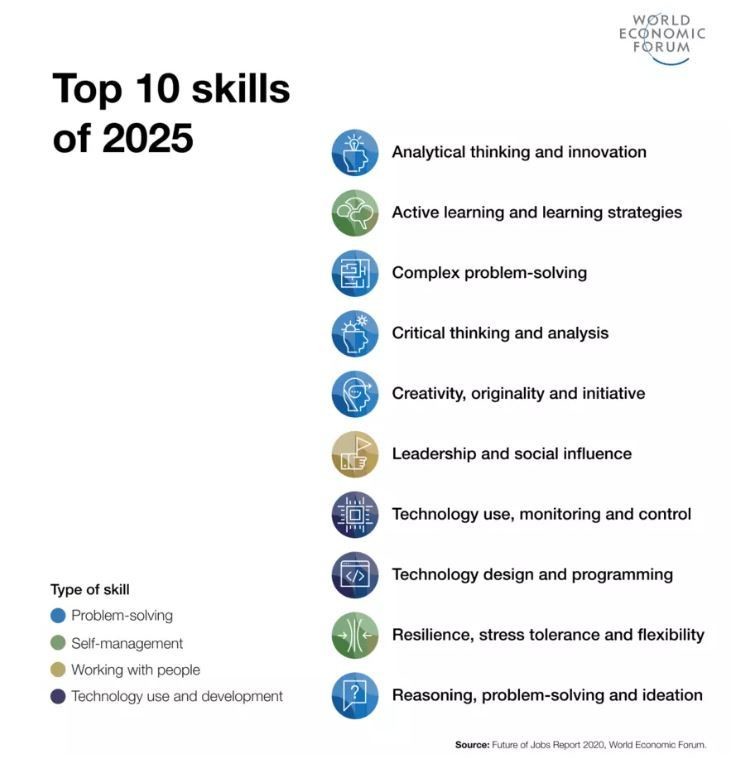
In 2020, the top most sought-after skill was creativity.
Why are employees expected to have analytical thinking and innovation skills? Why is creativity not enough?
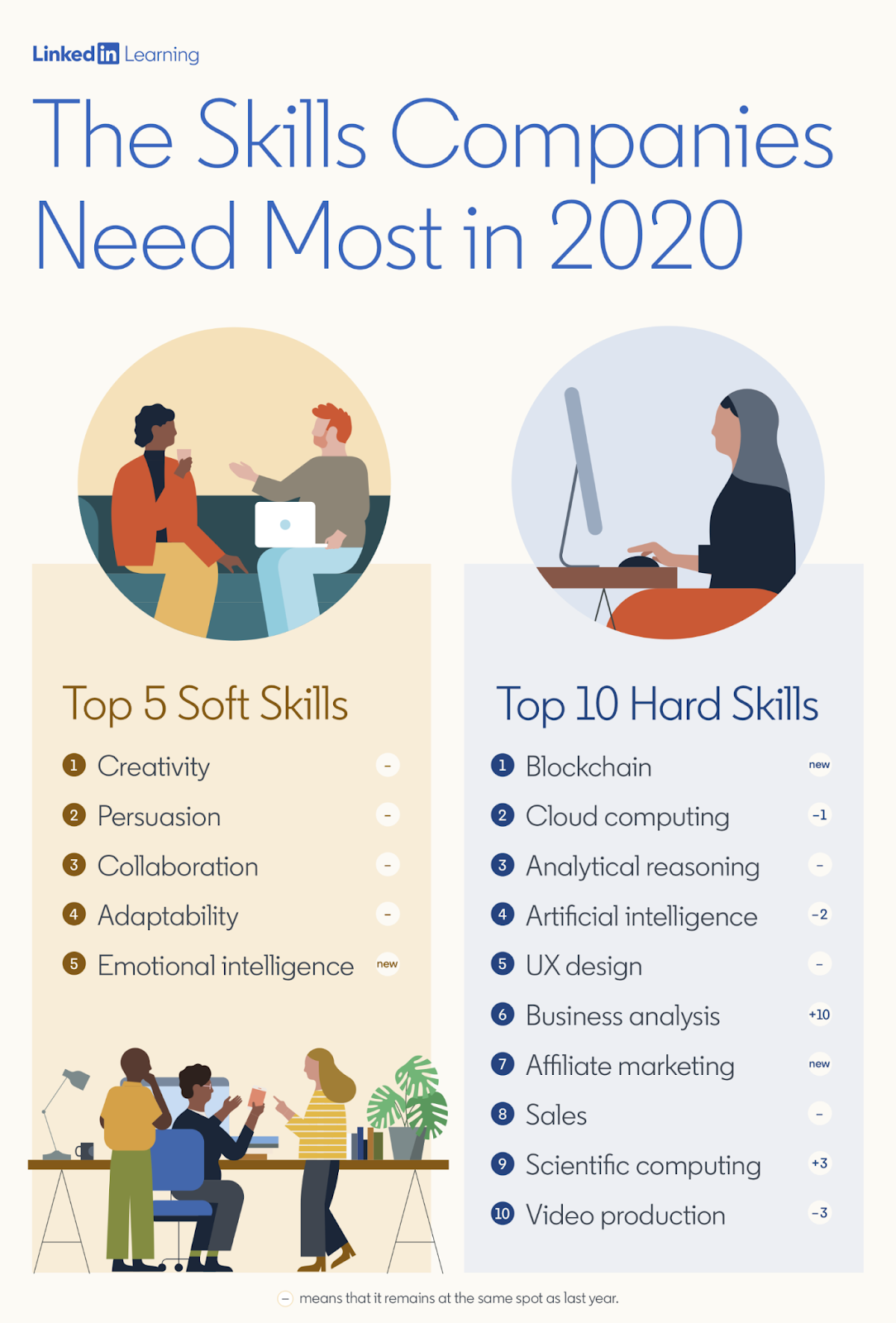
The World Economic Forum report answers this question with an in-depth list of key insights which I encourage you to read.
But if you want the short answer, here’s my conclusion.
The future of work is about automation and robots. The report found that by 2025, the time spent on current tasks at work by humans and machines will be equal.
While an AI software can do creative work (see the AI writing news or the AI doing movie trailers), software and automation robots cannot be innovative.
Innovation requires other skills besides creativity. Read on to find out what these skills are.
If innovation is not (only) creativity, then what is it? Is it a process? Is it a mindset?
First let’s establish the difference between creativity and innovation.
Creativity vs Innovation
On this subject, the best definition of innovation as opposed to creativity I could find is the following:
The key difference between creativity and innovation is that the first refers to generating a fresh and new idea, whereas the second implies initiating new service, product or invention to the market, which was not introduced before.
Creativity vs Invention vs Innovation
Let’s bring another term into the conversation, one that is commonly used to define innovation: invention.
Does invention equals innovation? And if it doesn’t, what’s the difference between invention and innovation?
To answer this question, here’s a great piece of content from Innoway, an innovation consultancy:
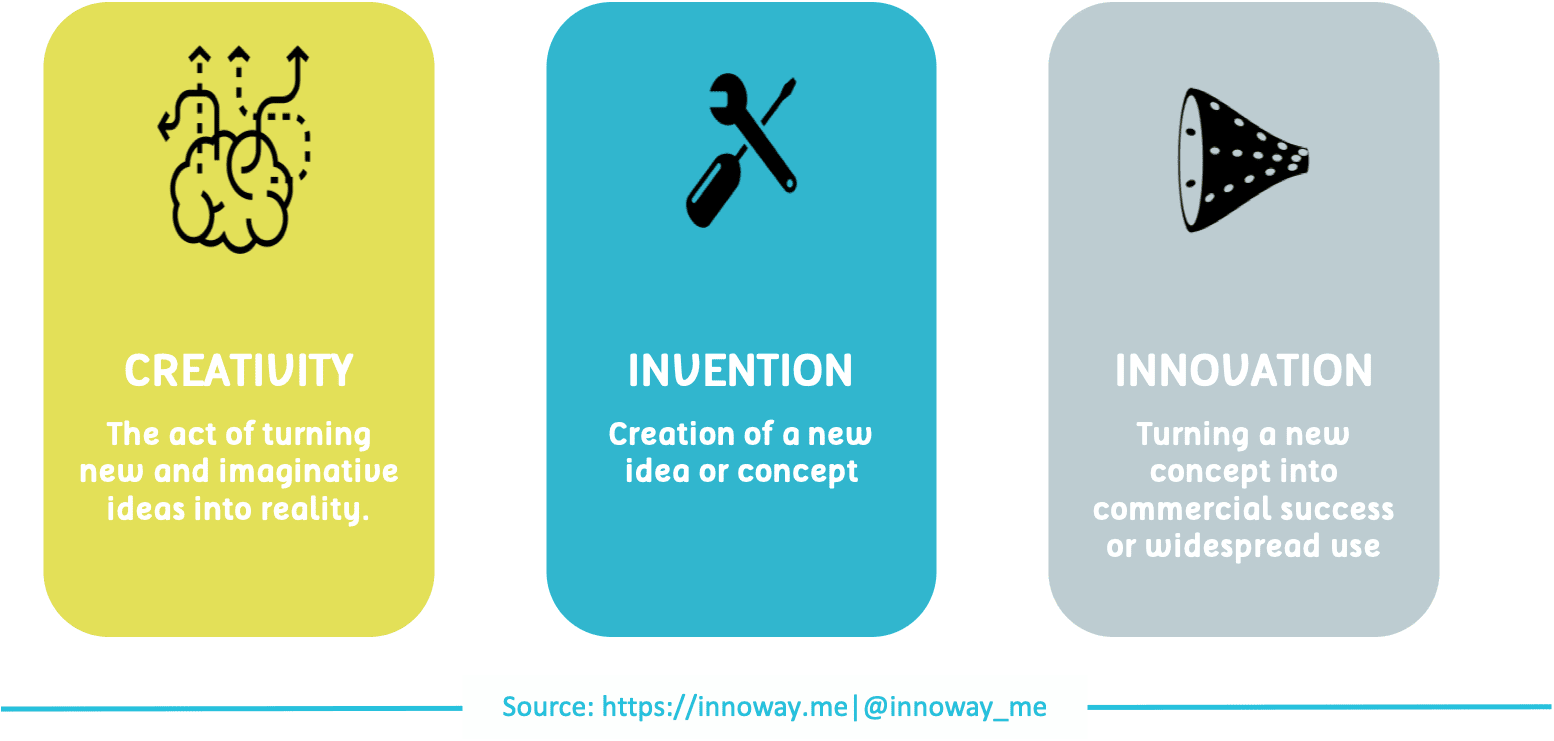
They do a great job of explaining the difference between creativity, invention and innovation.
Creativity is the art of turning new and imaginative ideas into reality.
Invention is the creation of a new idea or concept.
Innovation is turning a new concept into commercial success or widespread use.
Zaha Hadid’s amazing buildings are a testament to her creativity, but they are neither inventions, nor innovations.
Leonardo da Vinci, the famous painter was also a prolific inventor. Among his many designs was that of a helicopter which he called the Aerial Screw.
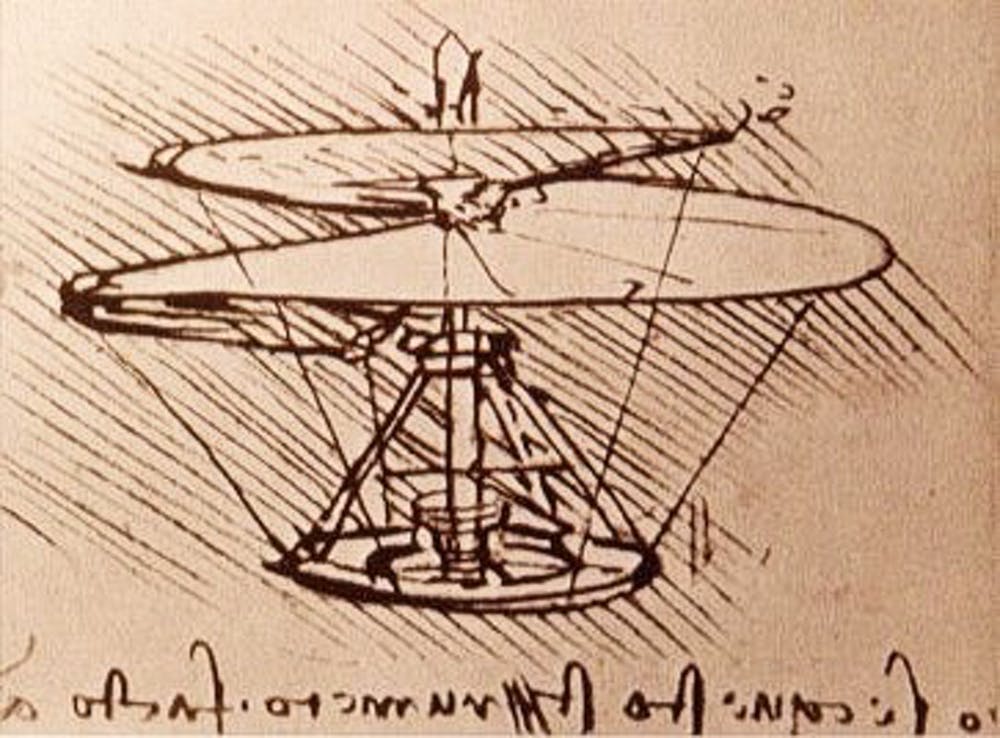
Leonardo da Vinci’s helicopter
If you look at da Vinci’s sketch dating back to the 1480s, you will notice a very strong resemblance with NASA’s Ingenuity Helicopter which took its first flight on Mars earlier this month.
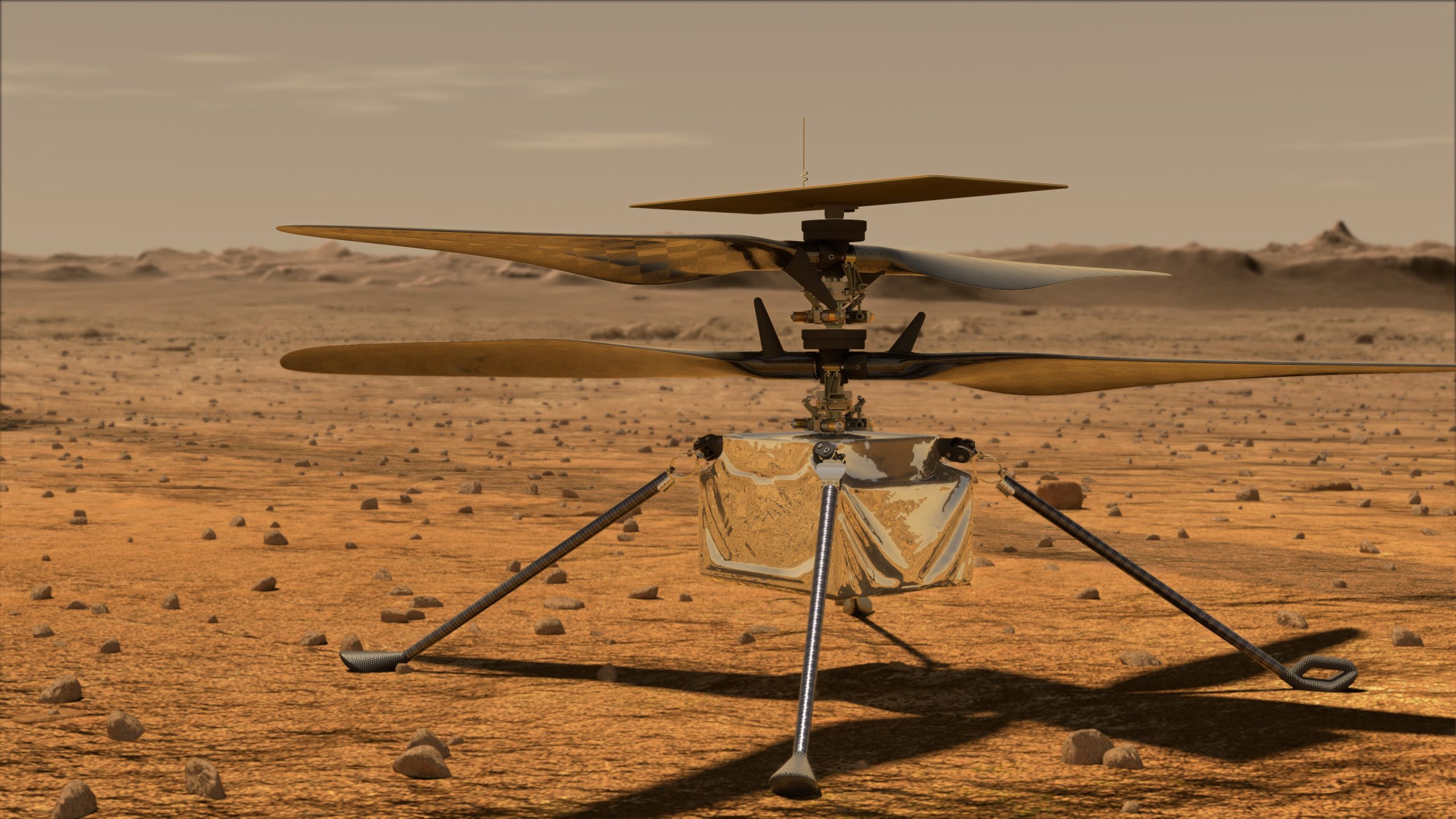
Ingenuity helicopter, source: NASA
Taking inspiration from Leonardo’s concept, the engineers at NASA were prompted to solve a series of challenges related to Mars’ atmosphere. The Red Planet’s atmosphere is 99% less dense than Earth’s which makes it difficult for the helicopter to achieve enough lift.
The Aerial Screw is an invention while the Ingenuity is an innovation.
What is innovation?
Innovation sits at the intersection of customer desires, technology and business opportunities.
Innovation is defined as something new to the market that creates economic and customer value through research, creativity and invention.
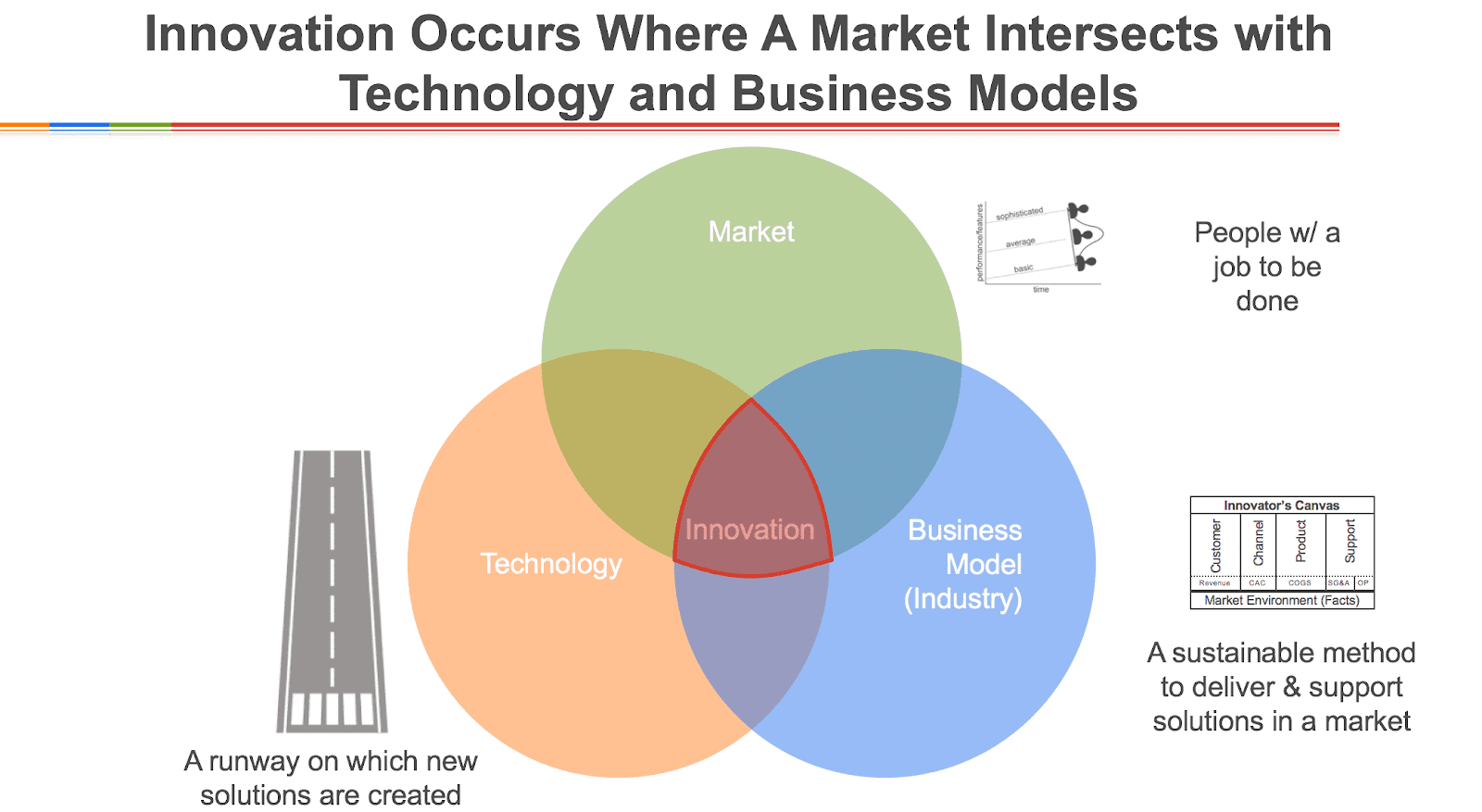
source: ignitionframework.com
Innovation occurs where a market intersects with technology and business models.
The market is composed of people with a job to be done. The business model is a sustainable method to deliver and support solutions in a market. Technology is a runway on which new solutions are created.
Innovators start with the market in mind and what the customers want or need.
Technology is not a goal, it’s a means to an end. Innovators ask themselves How can I use technology to address an unmet need in the market? What technology-driven solution can I come up with that provides customers with a solution to their problems and revenue for the company?
This is what innovators think about when they wake up in the morning and when they go to sleep at night.
The 4 types of innovation
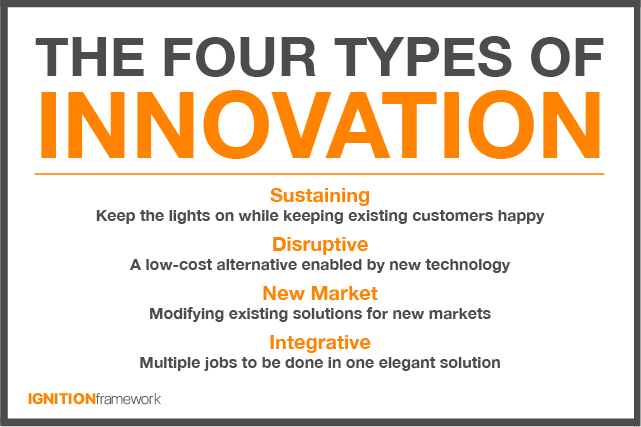
Jake Nielson, a marketing leader with 10+ years of innovation management experience came to the conclusion that there are 4 types of innovation:
- sustaining innovation;
- disruptive innovation;
- new market innovation;
- integrative innovation.
Sustaining innovation
Apple is an example of sustaining innovation. Since the first iPhone in 2007, the company has come up with new iterations of the iPhone every year. Every iteration had new features, improved functionality, beautiful design and innovations.
Disruptive innovation
Airbnb disrupted the hospitality industry. Uber disrupted the taxi industry. Netflix disrupted the DVD mail service. Amazon disrupted brick and mortar commerce. All four provide a better alternative enabled by new technology.
New market innovation
BMW has been manufacturing conventional cars since the early 1950s. Starting with the 1970s, the German car maker has been researching and testing electric cars. Today BMW electric cars are among the best in the market and the company is planning to offer plug-in hybrid versions of all its core-brand models.
Integrative innovation
MailChimp started out as an email provider for small businesses. The company’s email service was so successful that it became one of the most popular in the world. Listening to their customers’ needs, MailChimp expanded its services. MailChimp is now more than an email service provider, it’s an all-in-one marketing platform which empowers its users to build landing pages, create digital campaigns and leverage powerful insights. It supports small businesses to reach their marketing goals faster.
What type of innovation is your company developing?
Join the Conversation
We’d love to hear what you have to say.
Get in touch with us on our LinkedIn Page, Facebook Page, Twitter or TikTok.
Last days to join Business Strategy for Top Executives Masterclass with Costas Markides
Next week on March 23, 2021, founders and entrepreneurs, CEOs and investors, business developers and sales executives will participate in Business Strategy for Top Executives Masterclass with acclaimed Prof Costas Markides.
If you’re looking to turn your business from disrupted to disruptor and find innovative ways to thrive, then this masterclass is for you.
These are the last days you can get your tickets.
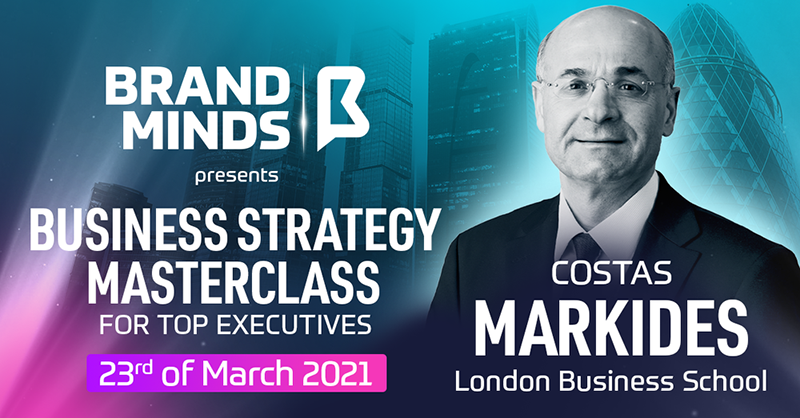
The masterclass is held online through live streaming. It starts at 9 am and ends at 5 pm with a Q&A session which is a great opportunity to get answers to your questions. An outside perspective over your particular situation is invaluable. It could light a new pathway that you couldn’t have seen otherwise.
Here is the agenda of Business Strategy for Top Executives Masterclass:
Session 1: STRATEGY IN A VOLATILE WORLD
Success doesn’t come by chance or fall in your lap. It’s the result of a well-thought strategy and an excellent implementation plan.
You know how they say about overnight success?
This overnight success has taken ten years of hard work and perseverance.
That’s why you need a strategy for your business. And given the volatile nature of the world we are living in, even more so today.
Every successful business has a successful strategy. Remember: strategy before tactics.
Amazon’s main strategy is to focus on their customers. But the global leader of the ecommerce market doesn’t just listen to its customers.
Year after year, since 1997, Amazon sets out to delight its customers.
And that’s the drive pushing every improvement and product or service that the company has ever made: its search recommendation engine, AWS, one-click purchase, Alexa and so on.
Join the masterclass to upgrade and improve your business strategy!
Session 2: STRATEGIC AGILITY IN TODAY’S WORLD
There has never been a better time to go agile in business. Times are changing quickly and the business environment must adapt and keep up.
In 2014, consulting company McKinsey & Co introduced two new dimensions to their organisational surveys: speed and flexibility.
They described the companies that combined both as agile.
Companies that are agile can adapt quickly to new challenges and opportunities. They mobilize quickly and show a strong relationship between organizational health and the creation of value. They move to market faster than traditional companies and have lower costs.
Join the masterclass to discover ways to create strategic agility for your business!
Session 3: MOBILIZING THE WHOLE ORGANISATION FOR STRATEGY EXECUTION
Whether you lead a business of thousands of employees or a small team of five, you need to be aware that for the strategy to work, everyone must be on board.
Every employee, from front desk to product development to supplier quality has to understand the strategy, contribute to its implementation and be on the same page with everyone else.
Learn from strategy expert Costas Markides how to mobilize your organisation for strategy execution.
Session 4: NEW CHALLENGES FOR LEADERS
One of the abilities that successful leaders need to develop or acquire is the ability to see around the corner.
What does that mean?
It means to have one foot in the future.
It implies to be able to spot trends before they go mainstream and take steps to leverage them to the benefit of your business.
It’s called strategic foresight. Strategic foresight allows companies to prepare for the future.
What challenges do leaders have to face in the near future?
Is it employee high turnover due to low engagement levels in the context of the work-from-home situation?
Everything going digital and online?
Changes in customer behaviour?
Attend the Business Strategy for Top Executives to find out!
Join the Conversation
We’d love to hear what you have to say.
Get in touch with us on our LinkedIn Page, Facebook Page, Twitter or TikTok.
Achieve competitive advantage with the Porter Diamond Model
Looking to achieve a competitive advantage in international markets? Apply the Porter Diamond Model!
On this page:
- What is the Porter Diamond Model?
- What are the four attributes discussed in Porter’s Diamond Model (with examples)?
- How do you use Porter’s Diamond?
1. What is the Porter Diamond Model?
The Porter Diamond Model, also known as the Porter Diamond Theory of National Advantage is a business framework that describes a nation’s competitive advantage in the international market.
The Porter Diamond Model also refers to innovation and why certain companies based in certain nations are capable of consistent innovation.
The model was created by economist and researcher Michael Porter whose expertise focuses on market competition and company strategy.
If you follow this blog, you are already familiar with Mr Porter and his earlier business framework, Porter’s 5 Forces.
2. What are the 4 attributes discussed in Porter’s Diamond Model?
The Porter Diamond Model analyzes a nation’s advantage against four broad attributes that each nation establishes and operates for its industries:
- Factor Conditions
- Demand Conditions
- Related and Supporting Industries
- Firm Strategy, Structure, and Rivalry
Porter Diamond Model – Attribute #1 – Factor Conditions
This attribute defines the nation’s position in factors of production, such as labour, land, natural resources, capital or infrastructure, necessary to compete in a given industry.
It is worth noting that these factors are not inherited, but created.
According to the Porter Diamond Model, having a general workforce that is high school or even college-educated doesn’t constitute a competitive advantage.
To become competitive in the industry, a nation’s workforce must be highly specialized in an industry’s particular needs.

In Germany, the largest industry sector is the automotive industry.
The country is a primary location for innovative car manufacturers and suppliers and home to powerful car manufacturers such as BMW, Audi, Volkswagen, Mercedes etc.
The German automotive industry benefits from a strong industrial core, first-class infrastructure, a highly-skilled workforce and cutting edge research and development.
One of the factors underlying the German success is that the workforce is created. German students benefit from the country’s dual system of education where they combine vocational education with apprenticeships. This type of education supplies the country with a steady flow of highly skilled workers.
Nations succeed in industries where they are particularly good at factor creation. Competitive advantage results from the presence of world-class institutions that first create specialized factors and then continually work to upgrade them.
Michael Porter
Porter Diamond Model – Attribute #2 – Demand Conditions
The second attribute of the Porter Diamond Model refers to the nature of home-market demand for the industry’s product or service.
Demand conditions include the nature of domestic buyers and of emerging buyer needs.
In a nation where the domestic buyers are the world’s most sophisticated and demanding buyers for the product or service, the nation’s companies gain competitive advantage.
Demanding domestic buyers pressure companies to improve, innovate and upgrade their products. Thus preparing them to rise to the challenges of buyers in other nations.

Amazon is leading the eCommerce industry in the US and worldwide.
What makes Amazon so successful on both domestic and international markets? The company’s focus on customer satisfaction.
Every product and service developed by Amazon is designed to delight customers and build a system around true customer obsession. Read this article to learn more.
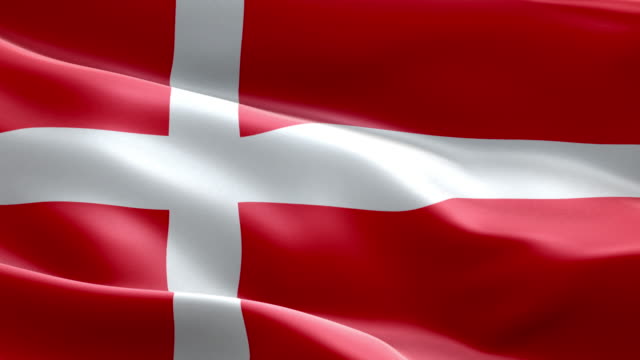
Denmark is the world’s leading country in cleantech.
40% of Denmark’s total power consumption is covered by wind turbines with the goal of raising to 55% by 2030.
Everyone in Denmark is working to achieve this goal: the government, local authorities, corporations and the public.
Denmark’s energy transformation started in the 1970s when the country faced a severe energy crisis which left Denmark crippled. In just a few decades, the country veered from fossil fuels to clean energy.
Today Denmark holds exceptional cleantech opportunities with a collaborative business environment, government support and attractive framework conditions.
Nations gain competitive advantage in industries where the home demand gives their companies a clearer or earlier picture of emerging buyer needs, and where demanding buyers pressure companies to innovate faster and achieve more sophisticated competitive advantages than their foreign rivals.
Michael Porter
Porter Diamond Model – Attribute #3 – Related and Supporting Industries
This attribute reveals the presence or absence in the nation of supplier industries and other related industries that are internationally competitive.
Internationally competitive home-based suppliers create advantages by delivering the most cost-effective inputs in an efficient, early, rapid, and sometimes preferential way. Developing a close relationship between your company and its home-based suppliers is mutually beneficial.
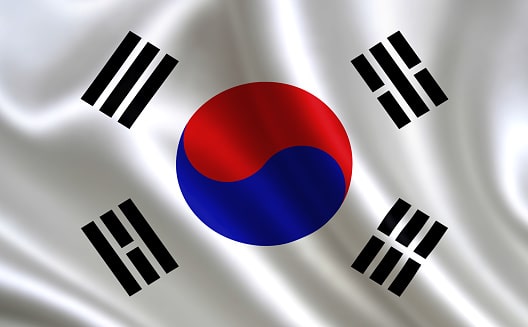
South Korea is the world’s largest producer of semiconductors. The semiconductors industry is a supplier for a wide range of other tech-oriented industries such as smartphone manufacturers, CCTV cameras, car manufacturers etc.
The country is home to leading high-tech companies such as Samsung, Hyundai or LG.
Porter Diamond Model – Attribute #4 – Firm Strategy, Structure, and Rivalry
The Firm strategy, structure and rivalry attribute highlights the conditions in the nation governing how companies are created, organized, and managed, as well as the nature of the domestic rivalry.
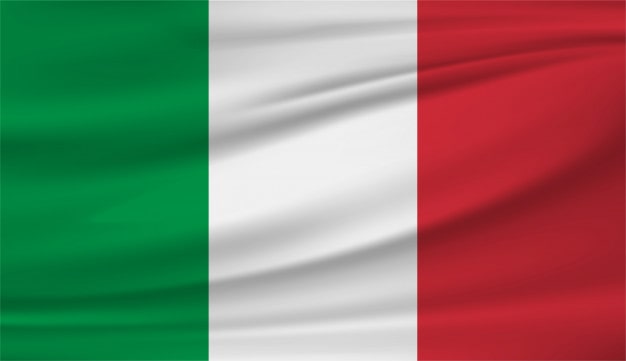
In Italy, for example, successful companies are often small or medium-sized family-run companies.
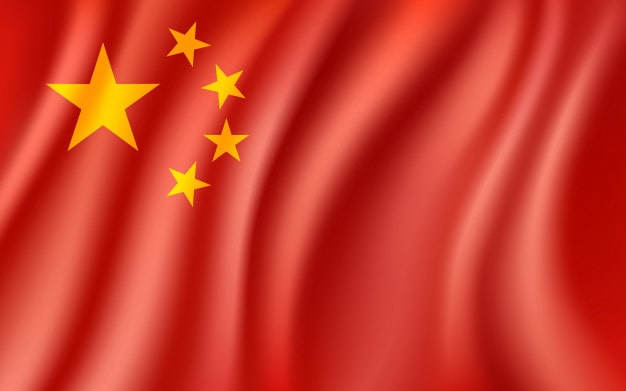
In China, 85% of enterprises are state-owned and lacking in market flexibility.

In the United Arab Emirates, the law required foreign companies to set up their businesses in partnership with an Emirati sponsor. Starting in November 2020, the government changed the law to allow 100% foreign ownership of businesses.
These four attributes make up the foundation upon which nations build their business environment. This environment determines how companies are born and how they learn to compete.
3. How do you use Porter’s Diamond?
Is your company looking to achieve international competitive success?
Here are 6 main insights provided by the Porter Diamond model:
- availability of resources necessary for competitive advantage in the industry of your choice;
- availability of skills necessary for competitive advantage in the industry of your choice;
- information that shapes the opportunities;
- directions in which companies deploy their resources and skills;
- goals of the owners, managers, and individuals in companies;
- the pressures on companies to invest and innovate.
If your company is planning to achieve a competitive advantage in the industry, investigate to which extent the national environment supports the rapid accumulation of specialized assets and skills.
Or whether or not the national environment affords better ongoing information and insight into product and process needs.
Does the national environment pressure companies to innovate and invest?
If the answers to these questions are affirmative, then your company could gain a competitive advantage and upgrade those advantages over time.
Join the Conversation
We’d love to hear what you have to say.
Get in touch with us on our LinkedIn Page, Facebook Page, Twitter or TikTok.
How Amazon, Nike and UiPath drive innovation
Innovation is at the core of Amazon, UiPath and Nike. Curious to know how these global companies drive innovation? Keep reading!
Amazon – Innovating by focusing on customer needs like no other company in the world
On December 15, 2020, Amazon announced that Twitter has selected AWS to provide global cloud infrastructure to deliver Twitter timelines.
A day before, Amazon launched Alexa’s new Live Translation feature. This feature allows individuals speaking in two different languages to converse with each other, with Alexa acting as an interpreter and translating both sides of the conversation.
Earlier this month, on December 8, 2020, Amazon Web Services (AWS) and the BMW Group announced a comprehensive strategic collaboration to further accelerate the automaker’s pace of innovation by placing data and analytics at the center of its decision-making.
These are just a few of the innovations that Amazon releases on a monthly basis. Amazon began focusing on technology innovations in the late 1990s.
The company’s first major breakthrough was its recommendation algorithm, also named recommendation engine.
In 2003, Amazon published a research paper which described a new way of filtering, the Item-to-item Collaborative Filtering.
“At Amazon.com, we use recommendation algorithms to personalize the online store for each customer. The store radically changes based on customer interests, showing programming titles to a software engineer and baby toys to a new mother”, was said in the paper.
Today, Amazon’s machine learning-powered recommendation engine drives 35% of its sales according to a McKinsey report.
An online bookstore initially, Amazon has become rapidly aware of the necessity of becoming a tech company.
In 2019, the research and development expenses of Amazon were around $36 billion compared to $16.9 billion of Microsoft.
Amazon’s investment supports the company to achieve its vision of becoming “Earth’s most customer-centric company.”
Here is a list of the most important innovations developed by Amazon:
Amazon Go
Amazon Go is a chain of convenience stores in the United States, operated by Amazon. The stores are partially automated, with customers able to purchase products without being checked out by a cashier or using a self-checkout station. There are currently 27 Amazon Go stores.
Amazon fulfillment centers
In every fulfilment centre, computer vision systems analyze images to help Amazon staff keep track of everything. Based on data, AI solves a large combinatorial optimization problem and decides which orders to pick at the same time in order to get them in the same box. This way the system minimizes the distance the transport pods have to travel. AI optimization makes these decisions in real-time and with information that is constantly changing.
Amazon Prime Now
Amazon Prime Now is an app which allows users to order tens of thousands of products to their homes with 1-hour delivery and FREE 2-hour delivery.
Amazon Prime Air
Amazon Prime Air is a service that will deliver packages up to five pounds in 30 minutes or less using small drones.
AWS – Amazon Web Services (AWS) is the world’s most comprehensive and broadly adopted cloud platform, offering over 175 fully featured services from data centers globally. The platform is used by individuals, companies, and governments, on a metered pay-as-you-go basis.
Alexa
Alexa is a virtual assistant AI technology developed by Amazon in 2014 and first used in the Amazon Echo smart speakers.
Kindle
Kindle is a series of e-readers which enable users to browse, buy, download, and read e-books, newspapers, magazines and other digital media. The device was launched in 2007.
Style Snap
StyleSnap is the latest Amazon AI-powered feature which supports fashion-focused shoppers.
Show and Tell
Show and Tell allows the blind to identify grocery items by holding each item to the Echo Show camera and ask, “Alexa, what am I holding?”. The smart speaker identifies the item through advanced computer vision and machine learning technologies for object recognition.
UiPath – The path to innovation is paved with humility
UiPath is the world’s leading Robotic Process Automation vendor.
For the second consecutive year, UiPath has been placed highest in the Leaders’ quadrant for ability to execute by Gartner.
In July 2020, UiPath became the first European Cloud Decacorn with $10.2Bn valuation in a new funding round of $225M.
At UiPath, innovation comes from actively listening to and engaging with the company’s customers. “Solving real-world problems using artificial intelligence (AI)—and pairing AI with RPA—motivates every individual at UiPath.”
The company gathers feedback from many touchpoints, including preview programs, its customer advisory board, their 400k+ user community, meetups, and conferences.
UiPath’s purpose is to accelerate human achievement. The company’s core values are speed, immersion, boldness and humility.
UiPath top management believes that if their people are not happy, they have failed no matter how successful the company is. That’s why being a successful leader at UiPath means exercising humility and practising active listening. The employee who is provided with psychological safety is more likely to focus on achieving the company’s business goals.
Nike – Innovation through knowledge and insights
Nike is no longer just an athletic shoe manufacturer, it’s a technology company.
The brand’s mission is to expand human potential. And to achieve that, Nike creates new products through game-changing innovations.
Most innovations come from the brand’s own lab, the Nike Sport Research Lab which the company set up in 1980. The lab focuses on biomechanics, physiology, sensory/perception and data science.
Over the course of thirty years, Nike’s lab, employing more than 40 researchers has grown into a world-class research facility. Its function is to provide knowledge and insights and turn data into innovative products for athletes.
The Nike Flywire support system, Lunarlite foam cushioning, Hyperdunk basketball shoe are among the most famous.
The latest innovation is Nike Fit, a foot-scanning solution designed to find every person’s best fit. Nike Fit uses a proprietary combination of computer vision, data science, machine learning, artificial intelligence and recommendation algorithms to find your right fit.
A report from 2017 estimated that Nike has spent “~$2.5 billion on research and development in the last five years.”
Read BUSINESS reSOURCES: a PESTEL analysis of Nike
Join the Conversation
We’d love to hear what you have to say.
Get in touch with us on our LinkedIn Page, Facebook Page, Twitter or TikTok.
March 2021: Business Strategy Masterclass for Top Executives with Prof. Costas Markides
Dear world-changer,
We have exciting news!
BRAND MINDS is launching Business Strategy Masterclass for Top Executives with London Business School professor Costas Markides.
The masterclass is scheduled for March 23rd, 2021 and will take place online. It starts at 9 am and ends at 5 pm with a Q&A session which is a great opportunity to get answers to your questions.
Check the agenda to find what you will learn at this masterclass:
Session 1: Strategy in a volatile world
Session 2: Strategic agility in today’s world
Session 3: Mobilizing the whole organisation for strategy execution
Session 4: New challenges for leaders
6 benefits of attending Business Strategy Masterclass for Top Executives
![]() BUILD CUSTOM BUSINESS MODELS
BUILD CUSTOM BUSINESS MODELS
Learn to develop custom business models and drive success through innovation.
![]() WORLD-CLASS EXECUTIVE EDUCATION
WORLD-CLASS EXECUTIVE EDUCATION
Acquire a premium learning experience from the former Executive Education Director of London Business School.
![]() EXPAND YOUR COMPANY
EXPAND YOUR COMPANY
Drive growth by exploring new business opportunities through networking with other Top Executive participants.
![]() BECOME THE ARCHITECT OF YOUR BUSINESS
BECOME THE ARCHITECT OF YOUR BUSINESS
Acquire the necessary business tools to plan your company’s future efficiently.
![]() LEARN BUSINESS INNOVATION PRINCIPLES
LEARN BUSINESS INNOVATION PRINCIPLES
Upgrade your knowledge on innovation and disruption to drive business success.
![]() IMPROVE YOUR DECISION-MAKING PROCESS
IMPROVE YOUR DECISION-MAKING PROCESS
In today’s fast-paced environment, making good decisions fast is an invaluable skill.
Are you a CEO, investor, business owner, sales expert, marketing manager, HR director or strategy specialist?
Then this masterclass is for you!
Discover additional benefits for you and your business

Prof Costas Markides – One of the world’s foremost experts on strategy & innovation
A business author and strategic thinker, Costas Markides has been a professor at London Business School for the past 30 years teaching Strategy & Entrepreneurship.
As the holder of the Robert P. Bauman Chair of Strategic Leadership at London Business School, Costas Markides’ role is to create innovative educational approaches that shape the next generation of strategic leaders.
He received his MBA and DBA from Harvard Business School and served as the Faculty Director of Executive Education at London Business School until 2016.
His expertise includes strategic innovation, business model innovation, diversification and international acquisitions.
A skilful professor, he won 5 awards recognizing his excellence in teaching and innovation in learning over the past ten years.
He is the bestselling author of Fast Second: How Smart Companies Bypass Radical Innovation to Enter and Dominate New Markets and Game-Changing Strategies: How to Create New Market Space in Established Industries by Breaking the Rules.
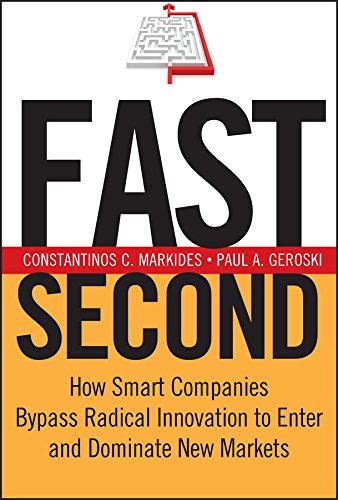
Fast Second illustrates how to determine which new markets have the potential to be successful and how to move into them before the competition does, when to make a move into a new market, how to scale up a market, where to position a company in the market, and whether to be a colonizer or a consolidator.
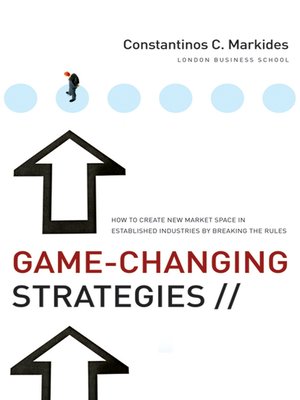
Game-Changing Strategies presents practical ideas on how established firms could not only discover new radical business models but also grow them next to their existing business models.
His forthcoming book is entitled Architects of Change and is set to launch in April 2021. The new book explores how individuals could design innovative solutions to social problems in ways that make them easily scalable.
Costas is currently serving on several editorial boards of strategic management journals among which is Sloan Management Review, the research-based magazine published at the Massachusetts Institute of Technology (MIT).
Have a long term strategy, especially in a fast-changing world; listen to the customer, but don’t always do what they say; don’t feel threatened by disruptive innovation; promote innovation in the face of core resistance; and, finally, do your best to bridge the know-do gap.
COSTAS MARKIDES
Do you want to get your company ready for an amazing 2021?
Access now BRAND MINDS Business Strategy Masterclass for Top Executives with prof Costas Markides!
Join the Conversation
We’d love to hear what you have to say.
Get in touch with us on our LinkedIn Page, Facebook Page, Twitter, TikTok or YouTube.
Blue Ocean Strategy: How to differentiate from the competition
On this page:
- Definition of Blue Ocean Strategy – What is Blue Ocean Strategy? Who created Blue Ocean Strategy?
- Differences between Red Ocean Strategy and Blue Ocean Strategy in business and leadership
- 3 brands that have differentiated from the competition, generated new demand and found a new market
- How to create a blue ocean for your company through value innovation
What is Blue Ocean Strategy?
Every entrepreneur wishes their company was the only one in the market. No competitors, having all the customers to themselves. King of the castle ruling unchallenged over the country.
While for most entrepreneurs this dream is only wishful thinking, for some it’s reality.
These entrepreneurs (and we will talk about three of them later) have led their companies to great success by applying Blue Ocean Strategy.
Blue ocean strategy is the simultaneous pursuit of differentiation and low cost to open up a new market space and create new demand. It is about creating and capturing uncontested market space, thereby making the competition irrelevant. It is based on the view that market boundaries and industry structure are not a given and can be reconstructed by the actions and beliefs of industry players.
Who created the Blue Ocean Strategy?
Blue Ocean Strategy was created by management thinkers Chan Kim and Renée Mauborgne.
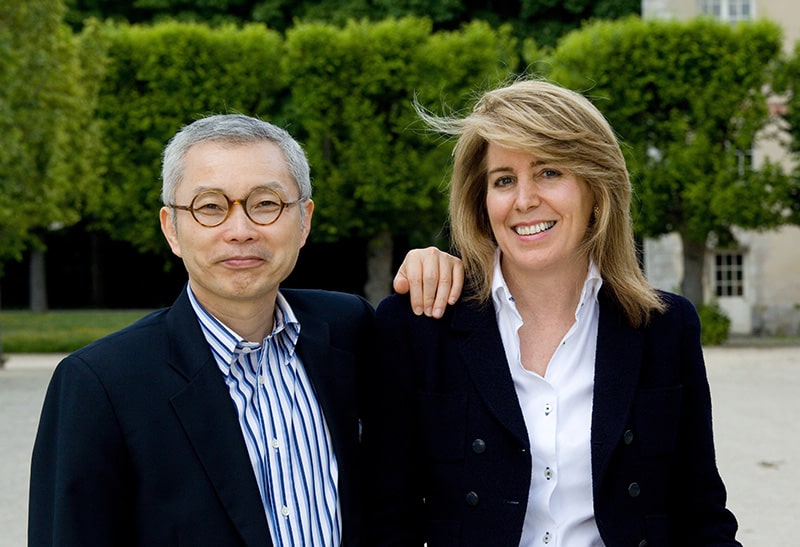
Chan Kim and Renée Mauborgne (image source: blueoceanstrategy.com)
Both Chan and Renée are Professors of Strategy at INSEAD, one of the world’s top business schools, and co-directors of the INSEAD Blue Ocean Strategy Institute in France.
In 2005, Chan Kim and Renée Mauborgne co-authored Blue Ocean Strategy. The book shows the results of a study of 150 strategic moves spanning more than 100 years across 30 industries. The authors’ conclusion is that lasting success comes not from battling competitors but from creating blue oceans – untapped new market spaces ripe for growth.
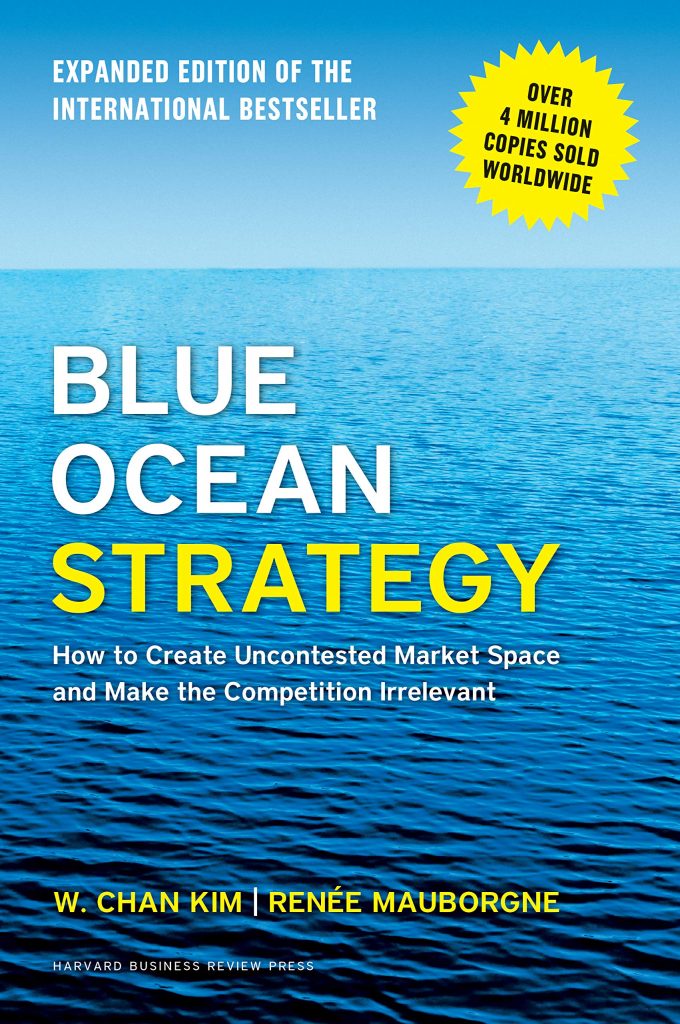
Since its first edition, Blue Ocean Strategy has been revised and expanded in 2015 and has become a bestseller with over 4 million copies sold in 46 languages.
The book is recognized as one of the most iconic and impactful strategy books ever written and is the recipient of numerous distinguished awards. Both authors received widespread recognition for their work in the form of various awards and distinctions.
Apart from their careers in academia, Chan and Renée have been employed in an advisory capacity by prestigious organizations. Kim is an advisory member for the European Union and serves as an advisor to several countries and Renée served on President Barack Obama’s Board of Advisors on Historically Black Colleges and Universities (HBCUs) for the president’s two terms.
In 2019, Thinkers50 named Chan Kim and Renée Mauborgne the #1 Business Thinkers in the World.

How to grow your business with 1 strategy framework
Differences between Red Ocean Strategy and Blue Ocean in business and leadership
In Blue Ocean Strategy, red ocean is a metaphor for the known market space encompassing all the industries in existence today. Remember the documentaries that showed the audience what happens when a large number of sharks feed at the same time, in the same place? It’s called a shark feeding frenzy event and it turns the ocean water red with the blood of the fish the sharks are feeding on.
Blue ocean is the metaphor for the unknown market space and all the industries that are not in existence today. It’s the unchartered land that courageous explorers venture in to discover unimaginable riches and opportunities.
- Red ocean strategy is about competition
- Blue ocean strategy is about creating new demand
- Red ocean strategy is a market-competing strategy where profit and growth decline while competition increases
- Blue ocean strategy is taking the opportunity to grow rapidly and profitably
- Red ocean strategy competes over customers
- Blue ocean strategy turn non-customers into customers
- Conventional leadership focuses on the cognitive and behavioural skills of leaders
- Blue ocean leadership focuses on actions and activities tied to market realities
- Conventional leadership has resulted in 87% global average in employee disengagement
- Blue ocean leadership’s goal is to unlock unrealized talent and energy in the organization fast and at low cost
3 Brands that have differentiated from the competition, generated new demand and found a new market
Cirque du Soleil

image source: Cirque du Soleil@Facebook
Founded in 1984 in Canada, Cirque du Soleil is an entertainment company and the largest contemporary circus producer in the world.
There’s circus in the company name but the performances are not your usual live animal children focused shows.
By taking out live animal acts from their performances and focusing on creating storyline-based shows with live music and amazing acrobats, Cirque du Soleil has created a new market space and new demand: circus entertainment for adults.
More than 180 million spectators have seen a Cirque du Soleil production since 1984 worldwide. The company generates annual revenue of approximately $1 billion and its creations have received numerous prizes and distinctions, including seven Primetime Emmy Awards and a star on the Hollywood Walk of Fame.
Uber & Airbnb
Both Uber and Airbnb are great examples of the blue ocean strategy.

Airbnb launched in 2008, Uber – one year later.
Although operating in the hospitality industry, Airbnb doesn’t own any property, it manages an online travel platform. By allowing homeowners to monetize their spaces and travellers to book them instead of hotels, Airbnb has found a new market, a big one.
The numbers speak for themselves: 7+ million listings worldwide, 2+ million people staying on Airbnb per night on average, 750+ million all-time Airbnb guest arrivals. In Q1 of 2019, Airbnb registered $9.4 billion in the total booking value.

Although Uber is operating in the people moving industry, it is not a taxi company, but a ridesharing service.
The latest stats say there are 21 million trips a day taken by 111 million monthly active platform consumers located in over 900 cities across 69 countries. In 2019, the company registered $65 billion in gross bookings across all platforms.
How to create a blue ocean for your company through value innovation
Value innovation is one of Blue Ocean Strategy’s tools and is defined as the simultaneous pursuit of differentiation and low cost, creating a leap in value for both buyers and the company.

10 questions to increase employee retention
The concept of Value Innovation is the cornerstone of the market-creating strategy.
Because value to buyers comes from the offering’s utility minus its price, and because value to the company is generated from the offering’s price minus its cost, value innovation is achieved only when the whole system of utility, price, and cost is aligned.
Chan Kim and Renee Mauborgne
But how does one achieve value innovation?
To achieve value innovation, the company looks at two factors: cost savings and buyer value.
The company makes cost savings by eliminating and reducing the factors an industry competes on and lifts buyer value by raising and creating elements the industry has never offered.
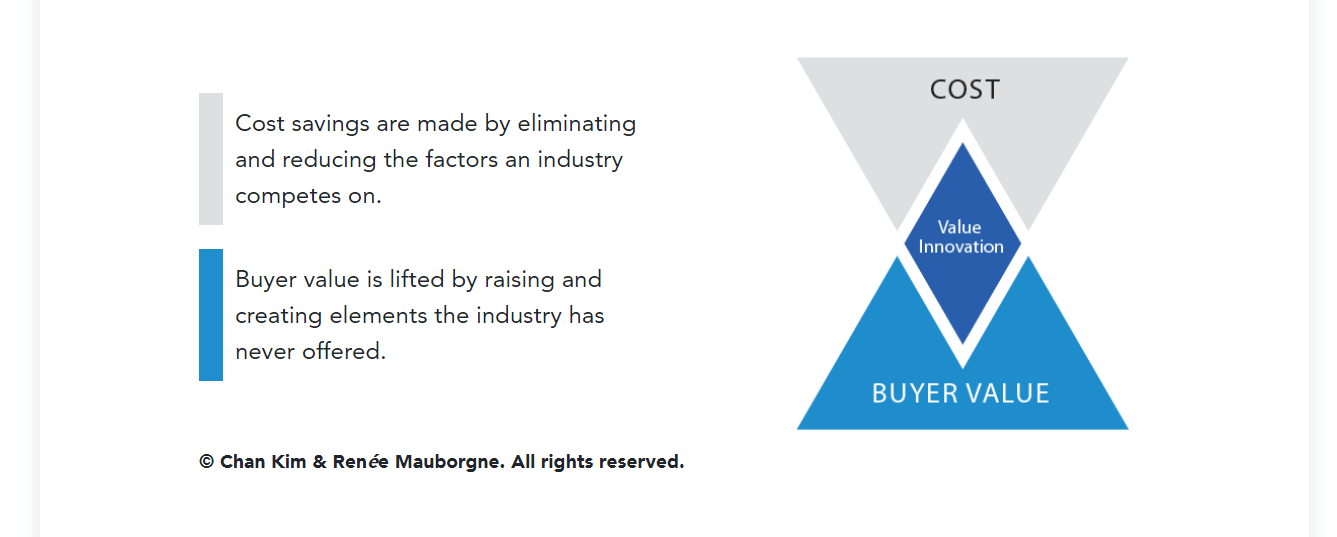
Many businesspeople believe that lowering costs and increasing value is a trade-off. It’s either creating greater value for customers at a higher cost or creating reasonable value at a lower cost. Blue Ocean Strategy allows companies to pursue differentiation and low cost simultaneously.
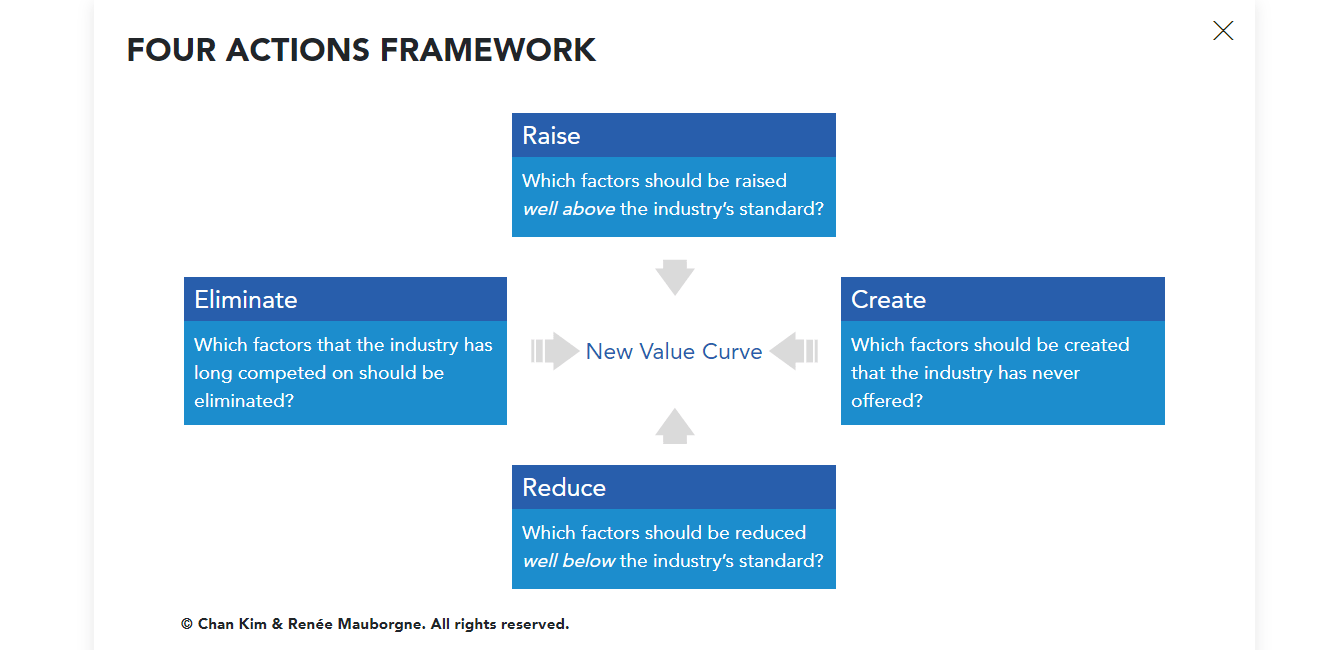
A great starting point for achieving value innovation is to answer the following questions devised by Chan Kim and Renee Mauborgne in the Four Actions Framework:
- Which of the factors that the industry takes for granted should be eliminated?
- Which factors should be reduced well below the industry’s standard?
- What factors should be raised well above the industry’s standard?
- What factors should be created that the industry has never offered?
In conclusion, to find your blue ocean, namely to tap into a new market, you need to perform an innovative leap in customer value at lower costs thus making the competition irrelevant.
Join the Conversation
We’d love to hear what you have to say.
Get in touch with us on our LinkedIn Group, Facebook Group or Twitter.
IKEA’s Latest Innovation – ThisAbles
IKEA Israel teamed up with disability rights groups to develop ThisAbles, an innovative line of 3D-printed add-ons for IKEA furniture.
Find out more in the video!
Join the Conversation
We’d love to hear what you have to say.
Get in touch with us on Facebook Group and Twitter.
Innovation in the pet food industry – E-commerce for dogs
Are you fed up with buying toys your dog doesn’t play with?
Wouldn’t you like your dog to let you know which toy to buy him?
Now it’s possible thanks to the AI facial recognition tool!
Join the Conversation
We’d love to hear what you have to say.
Get in touch with us on Facebook Group and Twitter.
